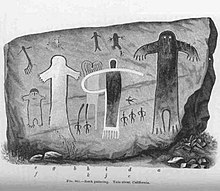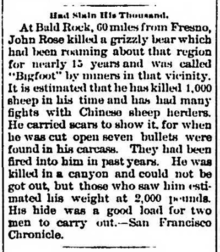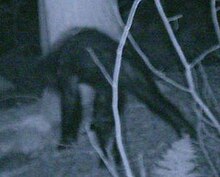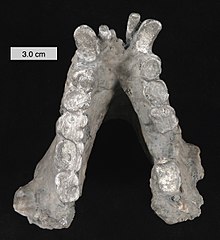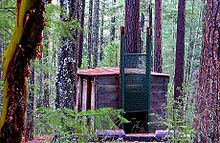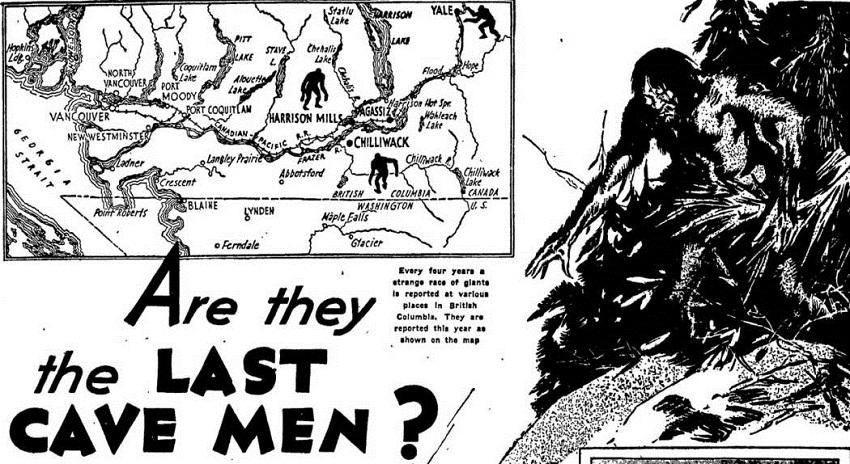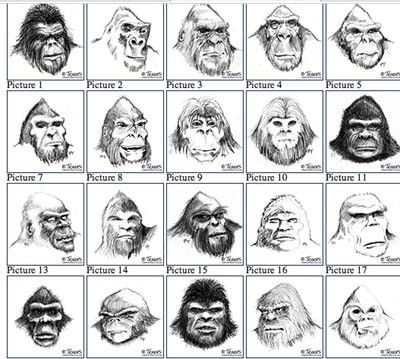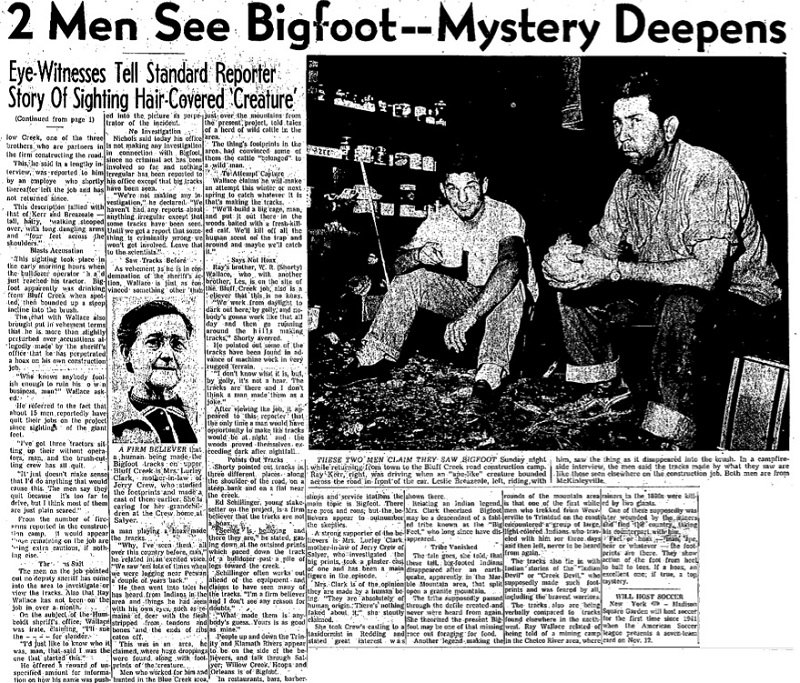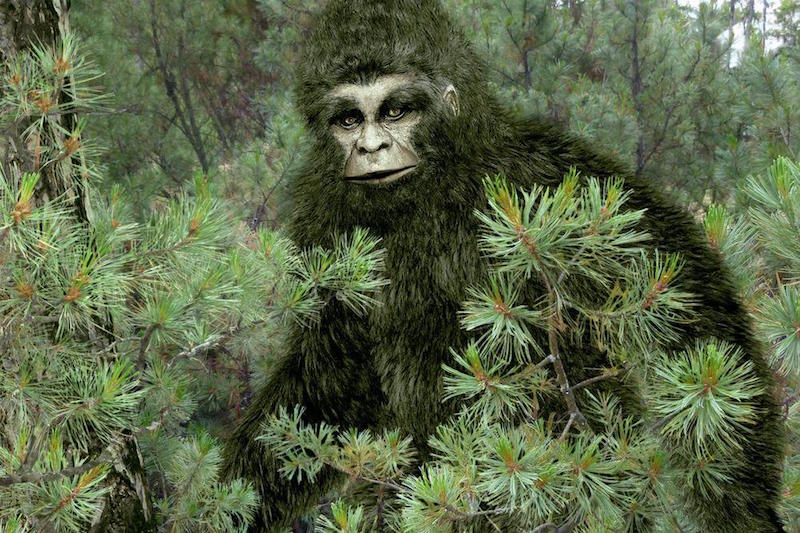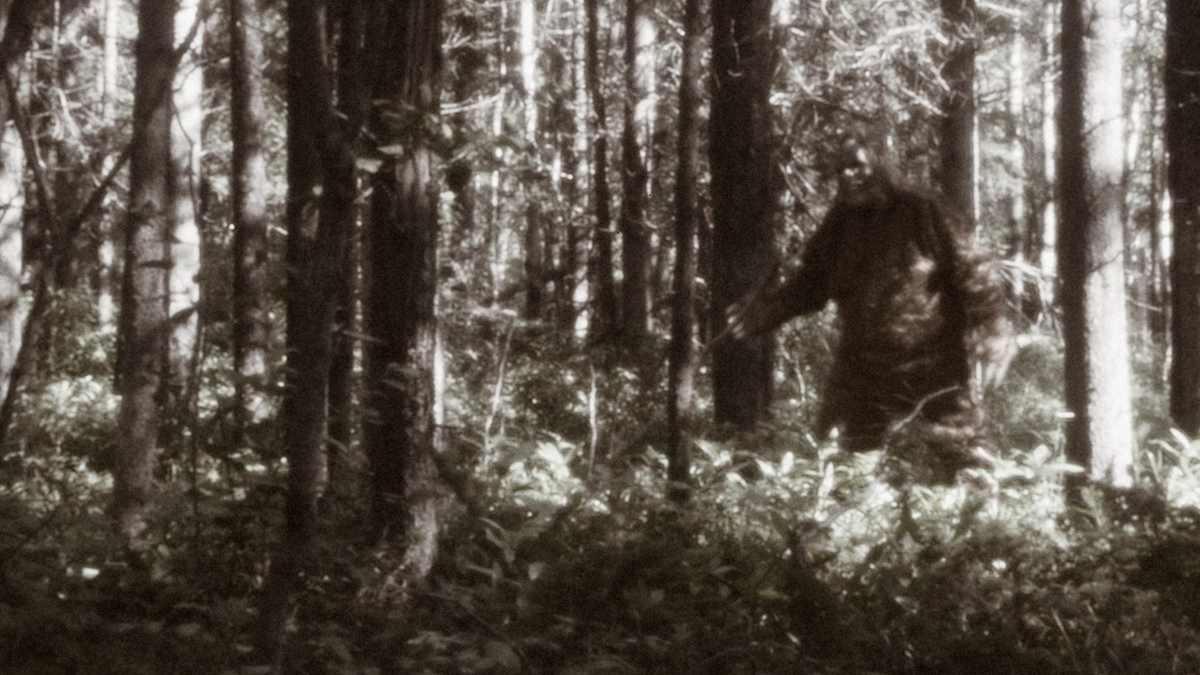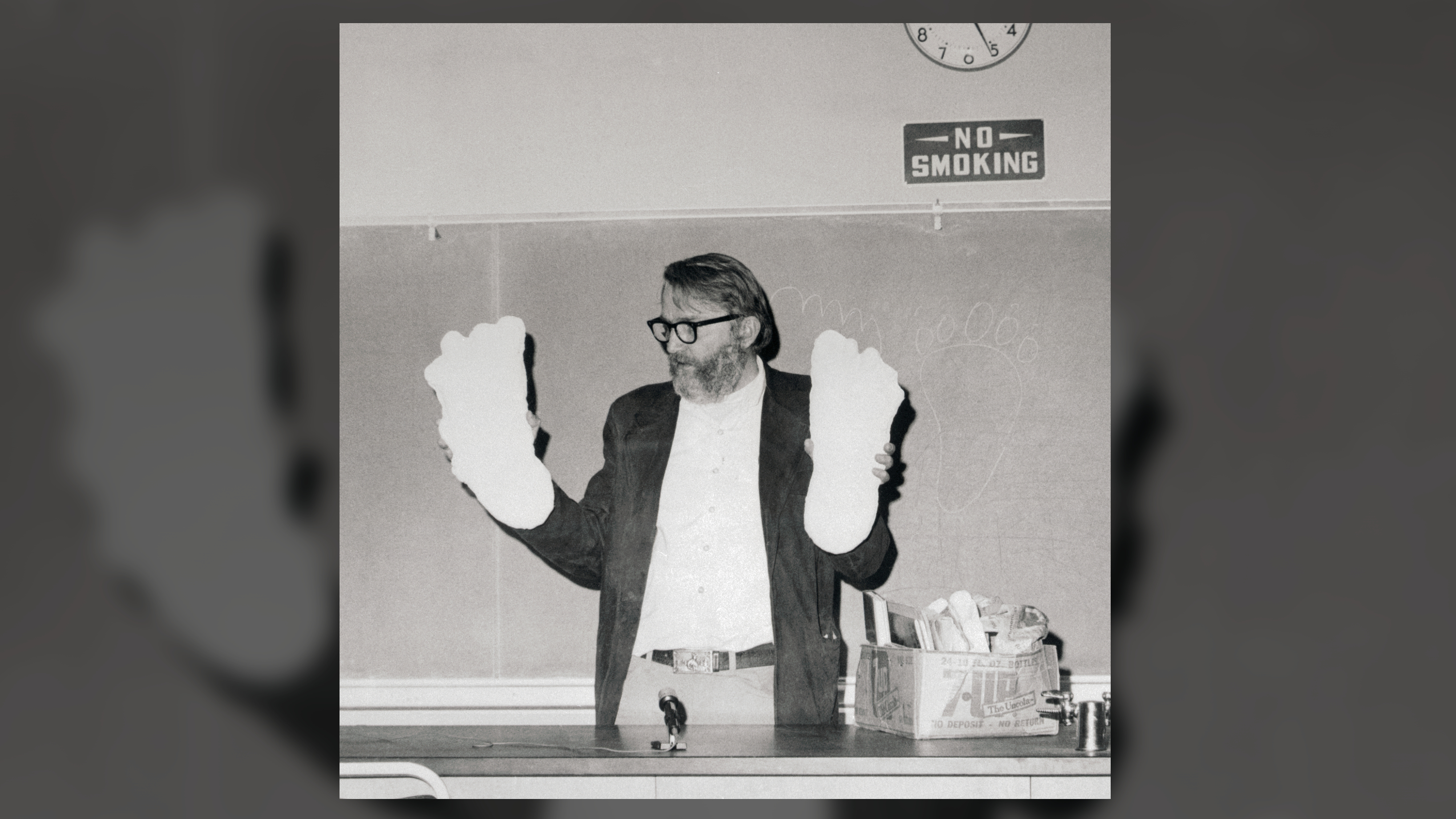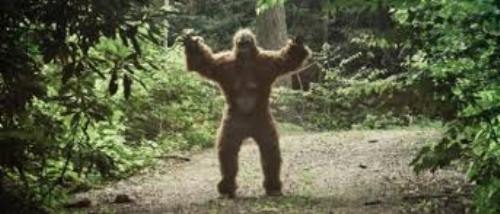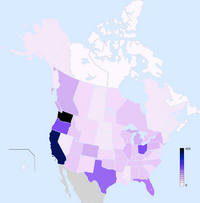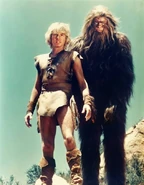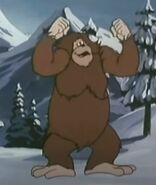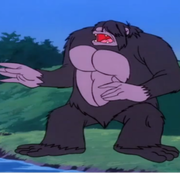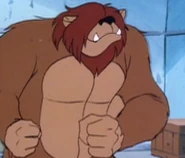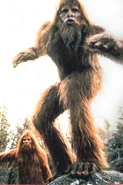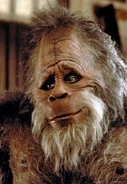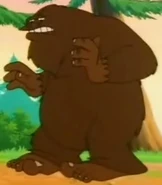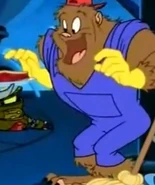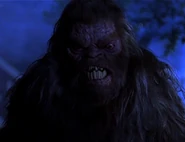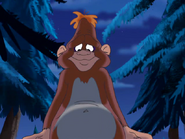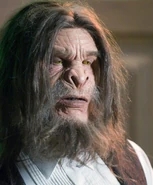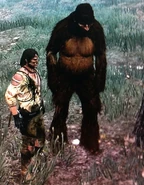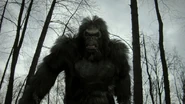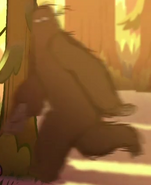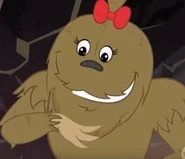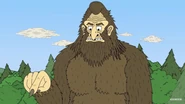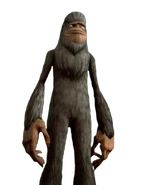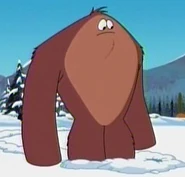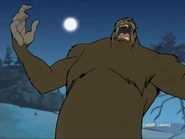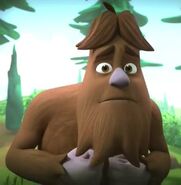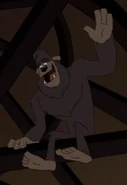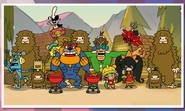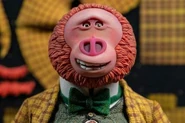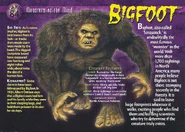Bigfoot is an ape-human type creature that many believe lives mostly in forests in the Pacific Northwest region of the North American continent. He is also often referred to as Sasquatch. He is often described as a large and hairy, resembling a half-man, half-ape creature in folklore and myths. Many of those who have reported seeing Bigfoot describe him with large eyes, a low-set forehead, large brow-ridge, and having enormous footprints. He is believed to be upwards of 500 pounds and anywhere from two to three meters tall. He is also reported to be rather smelly, and he is mainly nocturnal.
| Interesting Bigfoot Facts: |
|---|
|
The Bigfoot mystery has existed for hundreds of years in different countries around the world. |
|
Bigfoot is the most famous cryptid (unidentified creature that’s existence has not been proven). |
|
Russia, France and Germany have all placed Bigfoot on the endangered species list. |
|
Some believe that David Thompson was the first to discover Bigfoot in 1811 when he found a set of his footprints. |
|
Many believe that Bigfoot is vegetarian while others believe that he is a meat and plant eater. |
|
Early Native Americans believed that Bigfoot was a spiritual creature. |
|
Reports suggest that Bigfoot is brown, although many have also reported black, gray, white and greenish-blue Bigfoots. |
|
There have been too many eyewitness accounts of Bigfoot sightings for researchers to dismiss the idea of the possibility of Bigfoot’s existence. |
|
Many of the eyewitnesses who have reported to have seen Bigfoot are credible people, not those looking to gain fame or fortune or attention. |
|
There is DNA evidence to date to prove that Bigfoot exists. |
|
Bigfoot has many nicknames including Jacko, Jingera, Monkey Man, Old Skunky Bill, Rugaru, Tree Men, Windego, Wigidokowok, and Yeti (its Himilayan cousin), among many others. |
|
The first person to capture footage of Bigfoot was Roger Patterson. |
|
Some believe that Bigfoot makes howling sounds, and that he lives in swampy forests and near mountains. |
|
There is an Algonquin legend that a female Bigfoot named Yeahoh that fell in love with a lost hunter. It ended badly when he wanted to return home. |
|
It has been reported that Bigfoot is not bothered by pepper spray. It has also been reported that Bigfoots are not capable of sneezing. |
|
Some believe that Bigfoots are not ape-human creatures at all. They believe that they are extra-terrestrials. Nobody has been able to prove either theory because of the lack of DNA evidence. |
|
A Brazilian legend says that Bigfoot was captured in Brazil in 1867. It was fed berries, nuts, and bananas but didn’t like the bananas. It escaped soon after. |
|
Native Americans believed in Bigfoot long before the Europeans came to north America. |
|
Some believe that no remains of a Bigfoot have ever been found because Bigfoots bury their dead the same as humans do. |
|
Bigfoot hair samples have not been able to provide conclusive evidence because they do not match any other hair samples on record. |
|
Many Bigfoot tracks have been found in the Bluff Creek area. This is the same area where Roger Patterson would shoot his famous Bigfoot film footage. |
|
Frame 352 of the Patterson–Gimlin film, alleged to depict a female Bigfoot.[1] |
|
| Other name(s) | Sasquatch Other names |
|---|---|
| Country |
|
| Region | North America |
Bigfoot, also commonly referred to as Sasquatch, is a purported ape-like creature said to inhabit the forests of North America. Many dubious articles have been offered in attempts to prove the existence of Bigfoot, including anecdotal claims of sightings as well as alleged video and audio recordings, photographs, and casts of large footprints.[2] Some of which are known or admitted hoaxes.[3]
Tales of wild, hairy humanoids exist throughout the world,[4] and such creatures appear in the folklore of North America,[5] including the mythologies of indigenous people.[6][7] Bigfoot is an icon within the fringe subculture of cryptozoology,[8] and an enduring element of popular culture.[9]
The majority of mainstream scientists have historically discounted the existence of Bigfoot, considering it to be the result of a combination of folklore, misidentification, and hoax, rather than a living animal.[10][11] Folklorists trace the phenomenon of Bigfoot to a combination of factors and sources including indigenous cultures, the European wild man figure, and folk tales.[12] Wishful thinking, a cultural increase in environmental concerns, and overall societal awareness of the subject have been cited as additional factors.[13]
Other creatures of relatively similar descriptions are alleged to inhabit various regions throughout the world, such as the Skunk ape of the southeastern United States; the Almas, Yeren, and Yeti in Asia; and the Australian Yowie; all of which are also engrained in the cultures of their regions.[14]
Description
Bigfoot is most often described as a large, muscular, and bipedal ape-like creature covered in black, dark brown, or dark reddish hair.[16][17] Anecdotal descriptions estimate a height of roughly 1.8–2.7 metres (6–9 ft), with some descriptions having the creatures standing as tall as 3.0–4.6 metres (10–15 ft).[18] Some alleged observations describe Bigfoot as more «man-like»,[19] with reports of a human-like face.[20][21] In 1971, multiple people in The Dalles, Oregon, filed a police report describing an «overgrown ape», and one of the men claimed to have sighted the creature in the scope of his rifle, but could not bring himself to shoot it because, «It looked more human than animal».[22]
Common descriptions also include broad shoulders, no visible neck, and long arms, which skeptics describe as likely misidentification of a bear standing upright.[23] Some alleged nighttime sightings have stated the creature’s eyes «glowed» yellow or red.[24] However, eyeshine is not present in humans or any other known apes and so proposed explanations for observable eyeshine off of the ground in the forest include owls, raccoons, or opossums perched in foliage.[25]
Michael Rugg, owner of the Bigfoot Discovery Museum in Northern California, claims to have smelled Bigfoot, stating, «Imagine a skunk that had rolled around in dead animals and had hung around the garbage pits».[26]
The enormous footprints for which the creature is named are claimed to be as large as 610 millimetres (24 in) long and 200 millimetres (8 in) wide.[17] Some footprint casts have also contained claw marks, making it likely that they came from known animals such as bears, which have five toes and claws.[27][28]
History
Indigenous and early records
A reproduction of the petroglyphs at Painted Rock.
Many of the indigenous cultures across the North American continent include tales of mysterious hair-covered creatures living in forests,[29] and according to anthropologist David Daegling, these legends existed long before contemporary reports of «Bigfoot». These stories differed in their details both regionally and between families in the same community.[30]
On the Tule River Indian Reservation in Central California, petroglyphs created by a tribe of Yokuts at a site called Painted Rock are alleged by some to depict a group of Bigfoot called «the Family».[31] The local tribespeople call the largest of the glyphs «Hairy Man» and they are estimated to be between 500 and 1000 years old.[32] 16th century Spanish explorers and Mexican settlers in California told tales of the los Vigilantes Oscuros, or «Dark Watchers», large creatures alleged to stalk their camps at night.[33] In the region that is now Mississippi, a French Jesuit priest was living with the Natchez in 1721 and reported stories of hairy creatures in the forest known to scream loudly and steal livestock.[34]
Ecologist Robert Pyle argues that most cultures have accounts of human-like giants in their folk history, expressing a need for «some larger-than-life creature».[35] Each language had its own name for the creature featured in the local version of such legends. Many names mean something along the lines of «wild man» or «hairy man», although other names describe common actions that it was said to perform, such as eating clams or shaking trees.[36] Chief Mischelle of the Nlaka’pamux at Lytton, British Columbia told such a story to Charles Hill-Tout in 1898.[37]
The Sts’ailes people tell stories about sasq’ets, a shapeshifting creature that protects the forest. The name «Sasquatch» is the anglicized version of sasq’ets (sas-kets), roughly translating to «hairy man» in the Halq’emeylem language.[38]
Members of the Lummi tell tales about creatures known as Ts’emekwes. The stories are similar to each other in the general descriptions of Ts’emekwes, but details differed among various family accounts concerning the creature’s diet and activities.[39] Some regional versions tell of more threatening creatures: the stiyaha or kwi-kwiyai were a nocturnal race, and children were warned against saying the names so that the «monsters» would not come and carry them off to be killed.[40] The Iroquois tell of an aggressive, hair covered giant with rock-hard skin known as the Ot ne yar heh or «Stone Giant», more commonly referred to as the Genoskwa.[41] In 1847, Paul Kane reported stories by the natives about skoocooms, a race of cannibalistic wild men living on the peak of Mount St. Helens in southern Washington state. Also related to this area was an alleged incident in 1924 in which a violent encounter between a group of gold prospectors and a group of «ape-men» occurred. These allegations were reported in the July 16, 1924, issue of The Oregonian and have become a popular piece of Bigfoot lore, with the area now being referred to as Ape Canyon.[42] U.S. President Theodore Roosevelt, in his 1893 book, The Wilderness Hunter, writes of a story he was told by an elderly mountain man named Bauman in which a foul smelling, bipedal creature ransacked his beaver trapping camp, stalked him, and later became hostile when it fatally broke his companion’s neck in the wilderness near the Idaho-Montana border.[43] Roosevelt notes that Bauman appeared fearful while telling the story, but attributed the trapper’s folkloric German ancestry to have potentially influenced him.[44]
Less-menacing versions have also been recorded, such as one by Reverend Elkanah Walker from 1840. Walker was a Protestant missionary who recorded stories of giants among the natives living near Spokane, Washington. These giants were said to live on and around the peaks of the nearby mountains, stealing salmon from the fishermen’s nets.[45]
Origin of the «Bigfoot» name
In 1958, Jerry Crew, a logging company bulldozer operator in Humboldt County, California, discovered a set of large, 410 millimetres (16 in) human-like footprints sunk deep within the mud in the Six Rivers National Forest.[46] Upon informing his coworkers, many claimed to have seen similar tracks on previous job sites as well as telling of odd incidents such as an oil drum weighing 450 pounds (200 kg) having been moved without explanation. The logging company men soon began utilizing the term «Bigfoot» to describe the mysterious culprit.[47] Crew, who initially believed someone was playing a prank on them, once again observed more of these numerous, massive footprints and contacted reporter Andrew Genzoli of the Humboldt Times newspaper. Genzoli interviewed lumber workers and wrote articles about the mysterious footprints, introducing the name «Bigfoot» in relation to the tracks and the local tales of large, hairy wild men.[48] A plaster cast was made of the footprints and Crew appeared, holding one of the casts, on the front page of the newspaper on October 6, 1958. The story spread rapidly as Genzoli began to receive correspondence from major media outlets including the New York Times and Los Angeles Times.[49] As a result, the term «Bigfoot» became widespread as a reference to an apparently large, unknown creature leaving massive footprints in Northern California.[50]
In 2002, the family of Crew’s deceased coworker Ray Wallace stated that their father had been secretly making the large footprints with carved, wooden feet and that he was responsible for the tracks.[51] Despite the Wallace family’s statement, Willow Creek and Humboldt County are considered by some to be the «Bigfoot Capital of the World».[52]
Other historic uses of «Bigfoot»
1895 article describing a giant grizzly bear named «Bigfoot».[53]
In the 1830s, a Wyandot chief was nicknamed «Big Foot» due to his significant size, strength and large feet.[54] Potawatomi Chief Maumksuck, known as Chief «Big Foot», is today synonymous with the area of Walworth County, Wisconsin and has a state park and school named for him.[55] William A. A. Wallace, a famous 19th century Texas Ranger, was nicknamed «Bigfoot» due to his large feet and today has a town named for him: Bigfoot, Texas.[56] Lakota leader Spotted Elk was also called «Chief Big Foot». In the late 19th and early 20th centuries, at least two enormous marauding grizzly bears were widely noted in the press and each nicknamed «Bigfoot». The first grizzly bear called «Bigfoot» was reportedly killed near Fresno, California in 1895 after killing sheep for 15 years; his weight was estimated at 2,000 pounds (900 kg).[53] The second one was active in Idaho in the 1890s and 1900s between the Snake and Salmon rivers, and supernatural powers were attributed to it.[57]
Sightings
According to Live Science, there have been over 10,000 reported Bigfoot sightings in the continental United States.[58] About one-third of all claims of Bigfoot sightings are located in the Pacific Northwest, with the remaining reports spread throughout the rest of North America.[27][59][60] Most reports are considered mistakes or hoaxes, even by those researchers who claim Bigfoot exists.[61]
Sightings predominantly occur in the northwestern region of Washington, Oregon, Northern California, and British Columbia. Other prominent areas of supposed sightings include the rural areas of the Great Lakes region and the southeastern United States. According to data collected from the Bigfoot Field Researchers Organization’s (BFRO) Bigfoot sightings database in 2019, Washington has over 2,000 reported sightings, California over 1,600, Pennsylvania over 1,300, New York and Oregon over 1,000, and Texas has just over 800.[62] The debate over the legitimacy of Bigfoot sightings reached a peak in the 1970s, and Bigfoot has been regarded as the first widely popularized example of pseudoscience in American culture.[63]
Regional and other names
Many regions have differentiating names for the creatures.[64] In Canada, the name Sasquatch is widely used although often interchangeably with the name Bigfoot.[65] The United States uses both of these names but also has numerous names and descriptions of the creatures depending on the region and area in which they are allegedly sighted.[66] These include the Skunk ape in Florida and other southern states,[67] Grassman in Ohio,[68] Fouke Monster in Arkansas,[69] Wood Booger in Virginia,[70] the Monster of Whitehall in Whitehall, New York,[71] Momo in Missouri,[72] Honey Island Swamp Monster in Louisiana,[73] Dewey Lake Monster in Michigan,[74] Mogollon Monster in Arizona,[75] the Big Muddy Monster in southern Illinois,[76] and The Old Men of the Mountain in West Virginia.[77] The term Wood Ape is also used by some as a means to deviate from the perceived mythical connotation surrounding the name «Bigfoot».[78] Other names include Bushman, Treeman, and Wildman.[79]
Alleged behavior
Some Bigfoot researchers allege that Bigfoot throws rocks as territorial displays and for communication.[80][81][82] Other alleged behaviors include audible blows struck against trees or «wood knocking», further alleged to be communicative.[83][84][85]
Skeptics argue that these behaviors are easily hoaxed.[86]
Additionally, structures of broken and twisted foliage seemingly placed in specific areas have been attributed by some to Bigfoot behavior.[87] In some reports, lodgepole pine and other small trees have been observed bent, uprooted, or stacked in patterns such as weaved and crisscrossed, leading some to theorize that they are potential territorial markings.[88] Some instances have also included entire deer skeletons being suspended high in trees.[89] In Washington state, a team of amateur Bigfoot researchers called the Olympic Project claimed to have discovered a collection of nests, and they had primatologists study them, with the conclusion being that they appear to have been created by a primate.[90]
Many alleged sightings are reported to occur at night leading to some speculations that the creatures may possess nocturnal tendencies.[91] However, experts find such behavior untenable in a supposed ape- or human-like creature, as all known apes, including humans, are diurnal, with only lesser primates exhibiting nocturnality.[92] Most anecdotal sightings of Bigfoot describe the creatures allegedly observed as solitary, although some reports have described groups being allegedly observed together.[93]
Alleged vocalizations
Alleged vocalizations such as howls, screams, moans, grunts, whistles, and even a form of supposed language have been reported and allegedly recorded.[94][95] Some of these alleged vocalization recordings have been analyzed by individuals such as retired U.S. Navy cryptologic linguist Scott Nelson. He analyzed audio recordings from the early 1970s said to be recorded in the Sierra Nevada mountains dubbed the «Sierra Sounds» and stated, «It is definitely a language, it is definitely not human in origin, and it could not have been faked».[96] Les Stroud has spoken of a strange vocalization he heard in the wilderness while filming Survivorman that he stated sounded primate in origin.[97] The majority of mainstream scientists maintain that the source of the sounds often attributed to Bigfoot are either hoaxes, anthropomorphization, or likely misidentified and produced by known animals such as owl, wolf, coyote, and fox.[98][99][100]
Alleged encounters
A story from 1924, often referred to as the «Battle of Ape Canyon», presents miners being attacked by large, hairy «ape men» that threw rocks onto their cabin roof from a nearby cliff after one of the miners allegedly shot one with a rifle.[101] In Fouke, Arkansas in 1971, a family reported that a large, hair-covered creature startled a woman after reaching through a window. This alleged incident was later deemed a hoax.[102]
In 1974, the New York Times presented the dubious tale of Albert Ostman, a Canadian prospector, who stated that he was kidnapped and held captive by a family of Bigfoot for six days in 1924 in Toba Inlet, British Columbia.[103]
The 2021 Hulu documentary series, Sasquatch, describes marijuana farmers telling stories of Bigfoots harassing and killing people within the Emerald Triangle region in the 1970s through the 1990s; and specifically the alleged murder of three migrant workers in 1993.[104] Investigative journalist David Holthouse attributes the stories to illegal drug operations using the local Bigfoot lore to scare away competition, specifically superstitious immigrants, and that the high rate of murder and missing persons in the area is attributed to human actions.[105]
There have also been reports of dogs allegedly being killed by a Bigfoot. In the early 1990s, 9-1-1 audio recordings were made public in which a homeowner in Kitsap County, Washington called law enforcement for assistance with a large subject, described by him as being «all in black», having entered his backyard. He previously reported to law enforcement that his dog was killed recently when it was thrown over his fence.[106][107] Anthropologist Jeffrey Meldrum notes that any large predatory animal is potentially dangerous to humans, specifically if provoked, but indicates that most anecdotal accounts of Bigfoot encounters result in the creatures hiding or fleeing from people.[108] Some amateur researchers have reported the creatures moving or taking possession of intentional «gifts» left by humans such as food and jewelry, and leaving items in their place such as rocks and twigs.[109] Skeptics argue that many of these alleged human interactions are easily hoaxed, the result of misidentification, or are outright fabrications.[110]
Proposed explanations
A black bear showcasing its ability to sit in a human-like fashion.
Various explanations have been suggested for sightings and to offer conjecture on what existing animal has been misidentified in supposed sightings of Bigfoot. Scientists typically attribute sightings either to hoaxes or to misidentification of known animals and their tracks, particularly black bears.[111][112]
Misidentification
The 2007 photo of an unidentified creature captured on a trail camera.
Bears
Mainstream scientists theorize that American black bears are a likely culprit for most Bigfoot sightings, particularly when observers view a subject from afar, are in dense foliage or there are poor lighting conditions.[113] Additionally, black bears have been observed and recorded walking upright, often as the result of an injury.[114] While upright, adult black bears stand roughly 1.5–2.1 metres (5–7 ft),[115] and grizzly bears roughly 2.4–2.7 metres (8–9 ft),[116] both within the range of anecdotal Bigfoot reports.
In 2007, the Bigfoot Field Researchers Organization put forward photos which they stated showed a juvenile Bigfoot. The Pennsylvania Game Commission, however, stated that the photos were of a bear with mange.[117] The Pennsylvania Game Commission unsuccessfully attempted to locate the suspected mangey bear. Scientist Vanessa Woods, after estimating that the subject in the photo had approximately 560 millimetres (22 in) long arms and a 476 millimetres (18.75 in) torso, concluded it was more comparable to a chimpanzee.[118]
Escaped apes
Some have proposed that sightings of Bigfoot may simply be people observing and misidentifying known great apes such as chimpanzees, gorillas, and orangutans that have escaped from captivity such as zoos, circuses, and exotic pets belonging to private owners.[119] This explanation is often proposed in relation to the Bigfoot-like Skunk ape, as some argue the humid subtropical climate of the southeastern United States could potentially support a population of escaped apes.[120]
Humans
Humans have been mistaken for Bigfoot, with some incidents leading to injuries. In 2013, a 21-year-old man in Oklahoma was arrested after he told law enforcement he accidentally shot his friend in the back while their group was allegedly hunting for Bigfoot.[121] In 2017, a shamanist wearing clothing made of animal furs was vacationing in a North Carolina forest when local reports of alleged Bigfoot sightings flooded in. The Greenville Police Department issued a public notice not to shoot Bigfoot in fear of someone in a fur suit mistakenly being injured or killed.[122] In 2018, a person was shot at multiple times by a hunter near Helena, Montana who claimed he mistook him for a Bigfoot.[123]
Additionally, some have attributed feral humans or hermits living in the wilderness as being another explanation for alleged Bigfoot sightings.[124][125] One famous story, the Wild Man of the Navidad, tells of a wild ape-man who roamed the wilderness of eastern Texas in the mid-19th century, stealing food and goods from local residents. A search party allegedly captured an escaped African slave who was attributed to the story.[126] During the 1980s, a number of psychologically damaged American Vietnam veterans were stated by the state of Washington’s veterans’ affairs director, Randy Fisher, to have been living in remote wooded areas of the state.[127]
Pareidolia
Some have proposed that pareidolia may explain Bigfoot sightings, specifically the tendency to observe human-like faces and figures within the natural environment.[128][129] Photos and videos of poor quality alleged to depict Bigfoots are often attributed to this phenomenon and commonly referred to as «Blobsquatch».[130]
Hoaxes
Both Bigfoot believers and non-believers agree that many of the reported sightings are hoaxes or misidentified animals.[131] Author Jerome Clark argues that the Jacko Affair was a hoax, involving an 1884 newspaper report of an ape-like creature captured in British Columbia. He cites research by John Green, who found that several contemporaneous British Columbia newspapers regarded the alleged capture as highly dubious, and notes that the Mainland Guardian of New Westminster, British Columbia wrote, «Absurdity is written on the face of it.»[132]
In 1968, the frozen corpse of a supposed hair covered hominid measuring 5 feet 11 inches (1.8 m) was paraded around the United States as part of a traveling exhibition. Many stories surfaced as to its origin such as it having been killed by hunters in Minnesota or killed by American soldiers near Da Nang during the Vietnam War. It was attributed by some to be proof of Bigfoot-like creatures. Primatologist John R. Napier studied the subject and concluded it was a hoax made of latex. Others disputed this, claiming Napier did not study the original subject. As of 2013, the subject, dubbed the Minnesota Iceman, is on display at the «Museum of the Weird» in Austin, Texas.[133]
Tom Biscardi, long-time Bigfoot enthusiast and CEO of «Searching for Bigfoot, Inc.», appeared on the Coast to Coast AM paranormal radio show on July 14, 2005, and said that he was «98% sure that his group will be able to capture a Bigfoot which they had been tracking in the Happy Camp, California area.»[134] A month later, he announced on the same radio show that he had access to a captured Bigfoot and was arranging a pay-per-view event for people to see it. He appeared on Coast to Coast AM again a few days later to announce that there was no captive Bigfoot. He blamed an unnamed woman for misleading him, and said that the show’s audience was gullible.[134]
On July 9, 2008, Rick Dyer and Matthew Whitton posted a video to YouTube, claiming that they had discovered the body of a dead Bigfoot in a forest in northern Georgia. Tom Biscardi was contacted to investigate. Dyer and Whitton received $50,000 from «Searching for Bigfoot, Inc.»[135] The story was covered by many major news networks, including BBC,[136] CNN,[137] ABC News,[138] and Fox News.[139] Soon after a press conference, the alleged Bigfoot body was delivered in a block of ice in a freezer with the Searching for Bigfoot team. When the contents were thawed, observers found that the hair was not real, the head was hollow, and the feet were rubber.[140] Dyer and Whitton admitted that it was a hoax after being confronted by Steve Kulls, executive director of SquatchDetective.com.[141]
In August 2012, a man in Montana was killed by a car while perpetrating a Bigfoot hoax using a ghillie suit.[142][143]
In January 2014, Rick Dyer, perpetrator of a previous Bigfoot hoax, said that he had killed a Bigfoot in September 2012 outside San Antonio. He claimed to have had scientific tests conducted on the body, «from DNA tests to 3D optical scans to body scans. It is the real deal. It’s Bigfoot, and Bigfoot’s here, and I shot it, and now I’m proving it to the world.»[144][145] He said that he had kept the body in a hidden location, and he intended to take it on tour across North America in 2014. He released photos of the body and a video showing a few individuals’ reactions to seeing it,[146] but never released any of the tests or scans. He refused to disclose the test results or to provide biological samples. He said that the DNA results were done by an undisclosed lab and could not be matched to identify any known animal.[147] Dyer said that he would reveal the body and tests on February 9, 2014, at a news conference at Washington University,[148] but he never made the test results available.[149] After the Phoenix tour, the Bigfoot body was taken to Houston.[150]
On March 28, 2014, Dyer admitted on his Facebook page that his «Bigfoot corpse» was another hoax. He had paid Chris Russel of «Twisted Toybox» to manufacture the prop from latex, foam, and camel hair, which he nicknamed «Hank». Dyer earned approximately US$60,000 from the tour of this second fake Bigfoot corpse. He stated that he did kill a Bigfoot, but did not take the real body on tour for fear that it would be stolen.[151][152]
In April 2022, a man in Mobile, Alabama posted photos he claimed were of a Bigfoot to his Facebook page, indicating the Mobile County Sheriff’s Office validated their authenticity and the team from Finding Bigfoot was being dispatched. The photos circulated on social media, attracting the attention of NBC 15. The man admitted the photos were an April Fools’ Day hoax.[153]
On July 7, 2022, wildlife educator and media personality Coyote Peterson released a post on Facebook in which he claimed to have discovered a large primate skull in British Columbia, indicating that he had excavated and smuggled the skull into the United States for primatologist review. He further claimed to have initially hidden the discovery due to concerns that government agencies may intervene. The post went viral, quickly garnering the attention of multiple scientists who dismissed the skull as likely a replica of a gorilla skull. Darren Naish, a vertebrate paleontologist, stated, «I’m told that Coyote Peterson does this sort of thing fairly often as clickbait, and that this is a stunt done to promote an upcoming video. Maybe this is meant to be taken as harmless fun. But in an age where anti-scientific feelings and conspiracy culture are a serious problem it—again—really isn’t a good look. I think this stunt has backfired».[154]
Gigantopithecus
Fossil jaw of the extinct primate Gigantopithecus blacki
Bigfoot proponents Grover Krantz and Geoffrey H. Bourne both believed that Bigfoot could be a relict population of the extinct southeast Asian ape species Gigantopithecus blacki. According to Bourne, G. blacki may have followed the many other species of animals that migrated across the Bering land bridge to the Americas.[155] To date, no Gigantopithecus fossils have been found in the Americas. In Asia, the only recovered fossils have been of mandibles and teeth, leaving uncertainty about G. blacki‘s locomotion. Krantz has argued that G. blacki could have been bipedal, based on his extrapolation from the shape of its mandible. However, the relevant part of the mandible is not present in any fossils.[156] The more popular view is that G. blacki was quadrupedal, as its enormous mass would have made it difficult for it to adopt a bipedal gait.
Matt Cartmill criticizes the G. blacki hypothesis:
The trouble with this account is that Gigantopithecus was not a hominin and maybe not even a crown group hominoid; yet the physical evidence implies that Bigfoot is an upright biped with buttocks and a long, stout, permanently adducted hallux. These are hominin autapomorphies, not found in other mammals or other bipeds. It seems unlikely that Gigantopithecus would have evolved these uniquely hominin traits in parallel.[157]
Bernard G. Campbell writes: «That Gigantopithecus is in fact extinct has been questioned by those who believe it survives as the Yeti of the Himalayas and the Sasquatch of the north-west American coast. But the evidence for these creatures is not convincing.»[158]
Extinct hominidae
Primatologist John R. Napier and anthropologist Gordon Strasenburg have suggested a species of Paranthropus as a possible candidate for Bigfoot’s identity, such as Paranthropus robustus, with its gorilla-like crested skull and bipedal gait[159] —despite the fact that fossils of Paranthropus are found only in Africa.
Michael Rugg of the Bigfoot Discovery Museum presented a comparison between human, Gigantopithecus, and Meganthropus skulls (reconstructions made by Grover Krantz) in episodes 131 and 132 of the Bigfoot Discovery Museum Show.[160] Bigfoot enthusiasts that think Bigfoot may be the «missing link» between apes and humans have promoted the idea that Bigfoot is a descendent of Gigantopithecus blacki, but that ape diverged from orangutans around 12 million years ago and is not related to humans.[161]
Some suggest Neanderthal, Homo erectus, or Homo heidelbergensis to be the creature, but, like all other great apes, no remains of any of those species have been found in the Americas.[162]
Scientific view
Expert consensus is that allegations of the existence of Bigfoot are not credible science.[163] Belief in the existence of such a large, ape-like creature is more often attributed to hoaxes, confusion, or delusion rather than to sightings of a genuine creature.[16] In a 1996 USA Today article, Washington State zoologist John Crane said, «There is no such thing as Bigfoot. No data other than material that’s clearly been fabricated has ever been presented.»[35]
As with other similar beings, climate and food supply issues would make such a creature’s survival in reported habitats unlikely.[164] Bigfoot is alleged to live in regions unusual for a large, nonhuman primate, i.e., temperate latitudes in the northern hemisphere; all recognized nonhuman apes are found in the tropics of Africa and Asia. Great apes have not been found in the fossil record in the Americas, and no Bigfoot remains are known to have been found. Phillips Stevens, a cultural anthropologist at the University at Buffalo, summarized the scientific consensus as follows:
It defies all logic that there is a population of these things sufficient to keep them going. What it takes to maintain any species, especially a long-lived species, is you gotta have a breeding population. That requires a substantial number, spread out over a fairly wide area where they can find sufficient food and shelter to keep hidden from all the investigators.[165]
In the 1970s, when Bigfoot «experts» were frequently given high-profile media coverage, McLeod writes that the scientific community generally avoided lending credence to such fringe theories by refusing even to debate them.[63]
Primatologist Jane Goodall was asked for her personal opinion of Bigfoot in a 2002 interview on National Public Radio’s «Science Friday». She joked, «Well, now you will be amazed when I tell you that I’m sure that they exist.»[166]
She later added, chuckling, «Well, I’m a romantic, so I always wanted them to exist», and finally, «You know, why isn’t there a body? I can’t answer that, and maybe they don’t exist, but I want them to.»[167] In 2012, when asked again by the Huffington Post, Goodall said «I’m fascinated and would actually love them to exist,» adding, «Of course, it’s strange that there has never been a single authentic hide or hair of the Bigfoot, but I’ve read all the accounts.»[168]
Paleontologist and author Darren Naish states in a 2016 article for Scientific American that if «Bigfoot» existed, an abundance of evidence would also exist that cannot be found anywhere today, making the existence of such a creature exceedingly unlikely.[169]
Naish summarizes the evidence for «Bigfoot» that would exist if the creature itself existed:
- If «Bigfoot» existed, so would consistent reports of uniform vocalizations throughout North America as can be identified for any existing large animal in the region, rather than the scattered and widely varied «Bigfoot» sounds haphazardly reported;
- If «Bigfoot» existed, so would many tracks that would be easy for experts to find, just as they easily find tracks for other rare megafauna in North America, rather than a complete lack of such tracks alongside «tracks» that experts agree are fraudulent;
- Finally, if «Bigfoot» existed, an abundance of «Bigfoot» DNA would already have been found, again as it has been found for similar animals, instead of the current state of affairs, where there is no confirmed DNA for such a creature whatsoever.[169]
«DeNovo: Journal of Science» article
A request to register the species name Homo sapiens cognatus was made by veterinarian Melba S. Ketchum,[170] lead of The Sasquatch Genome Project, following publication of «Novel North American Hominins, Next Generation Sequencing of Three Whole Genomes and Associated Studies», Ketchum, M. S., et al., in the DeNovo: Journal of Science, 13 Feb 2013.[171] The article examined 111 samples of blood, tissue, hair, and other specimens «characterized and hypothesized» to have been «obtained from elusive hominins in North America commonly referred to as Sasquatch.»
The title «DeNovo: Journal of Science» in which the paper was published was later found to be a Web site—registered only nine days before the paper was announced—whose first and only «journal» issue contained nothing but the «Sasquatch» article described above.[172][173]
In 2013, ZooBank, the non-governmental organization that is generally accepted by zoologists to assign species names, approved the registration request for the subspecies name Homo sapiens cognatus to be used for the reputed hominid more familiarly known as Bigfoot or Sasquatch.[174] «Cognatus» is a Latin term meaning «related by blood.»
According to a statement by an ICZN associate scientist, «ZooBank and the ICZN do not review evidence for the legitimacy of organisms to which names are applied – that is outside our mandate, and is really the job of the relevant taxonomic/biological community (in this case, primatologists) to do that. When H. s. cognatus was first registered, needless to say we received a lot of inquiry about it. We scrutinized the original description and registration of this name as best as we could, and as far as we can determine, all the requirements were fulfilled for establishing the new name. Thus, at the moment, we have no grounds to reject the scientific name. This says nothing about the legitimacy of the taxon concept – it’s just about whether the name was established according to the rules.»
Opinions of primatologists are generally against the existence of the purported species, as described above.
Researchers
Ivan T. Sanderson and Bernard Heuvelmans, founders of the subculture and pseudoscience of cryptozoology, have spent parts of their career searching for Bigfoot.[175] Later scientists who researched the topic included Jason Jarvis, Carleton S. Coon, George Allen Agogino and William Charles Osman Hill, though they later stopped their research due to lack of evidence for the alleged creature.[176]
John Napier asserts that the scientific community’s attitude towards Bigfoot stems primarily from insufficient evidence.[177] Other scientists who have shown varying degrees of interest in the creature are Grover Krantz, Jeffrey Meldrum, John Bindernagel, David J. Daegling,[178] George Schaller,[35][179][180] Russell Mittermeier, Daris Swindler, Esteban Sarmiento,[181] and Mireya Mayor.[182]
Formal studies
One study was conducted by John Napier and published in his book Bigfoot: The Yeti and Sasquatch in Myth and Reality in 1973.[183][better source needed] Napier wrote that if a conclusion is to be reached based on scant extant «‘hard’ evidence,» science must declare «Bigfoot does not exist.»[184] However, he found it difficult to entirely reject thousands of alleged tracks, «scattered over 125,000 square miles» (325,000 km2) or to dismiss all «the many hundreds» of eyewitness accounts. Napier concluded, «I am convinced that Sasquatch exists, but whether it is all it is cracked up to be is another matter altogether. There must be something in north-west America that needs explaining, and that something leaves man-like footprints.»[185]
In 1974, the National Wildlife Federation funded a field study seeking Bigfoot evidence. No formal federation members were involved and the study made no notable discoveries.[186] Also in 1974, the now defunct North American Wildlife Research Team constructed a «Bigfoot trap» in the Rogue River–Siskiyou National Forest in Jackson County, Oregon. It was baited with animal carcasses and captured multiple bears, but no Bigfoot.[187] Upkeep of the trap ended in the early 1980s, but in 2006 the United States Forest Service repaired the trap, which today is a tourist destination along the Collings Mountain hiking trail.[188]
Beginning in the late 1970s, physical anthropologist Grover Krantz published several articles and four book-length treatments of Sasquatch. However, his work was found to contain multiple scientific failings including falling for hoaxes.[189]
A study published in the Journal of Biogeography in 2009 by J.D. Lozier et al. used ecological niche modeling on reported sightings of Bigfoot, using their locations to infer preferred ecological parameters. They found a very close match with the ecological parameters of the American black bear, Ursus americanus. They also note that an upright bear looks much like a Bigfoot’s purported appearance and consider it highly improbable that two species should have very similar ecological preferences, concluding that Bigfoot sightings are likely misidentified sightings of black bears.[190]
In the first systematic genetic analysis of 30 hair samples that were suspected to be from Bigfoot-like creatures, only one was found to be primate in origin, and that was identified as human. A joint study by the University of Oxford and Lausanne’s Cantonal Museum of Zoology and published in the Proceedings of the Royal Society B in 2014, the team used a previously published cleaning method to remove all surface contamination and the ribosomal mitochondrial DNA 12S fragment of the sample. The sample was sequenced and then compared to GenBank to identify the species origin. The samples submitted were from different parts of the world, including the United States, Russia, the Himalayas, and Sumatra. Other than one sample of human origin, all but two are from common animals. Black and brown bears accounted for most of the samples, other animals include cow, horse, dog/wolf/coyote, sheep, goat, deer, raccoon, porcupine, and tapir. The last two samples were thought to match a fossilized genetic sample of a 40,000 year old polar bear of the Pleistocene epoch;[191] a second test identified the hairs as being from a rare type of brown bear.[192][193]
In 2019, the FBI declassified an analysis it conducted on alleged Bigfoot hairs in 1976. Amateur Bigfoot researcher Peter Byrnes sent the FBI 15 hairs attached to a small skin fragment and asked if the bureau could assist him in identifying it. Jay Cochran, Jr., assistant director of the FBI’s Scientific and Technical Services division responded in 1977 that the hairs were of deer family origin.[194][195]
Claims
An artist’s impression of the creature
After what The Huffington Post described as «a five-year study of purported Bigfoot (also known as Sasquatch) DNA samples»,[196] but prior to peer review of the work, DNA Diagnostics, a veterinary laboratory headed by veterinarian Melba Ketchum issued a press release on November 24, 2012, claiming that they had found proof that the Sasquatch «is a human relative that arose approximately 15,000 years ago as a hybrid cross of modern Homo sapiens with an unknown primate species.» Ketchum called for this to be recognized officially, saying that «Government at all levels must recognize them as an indigenous people and immediately protect their human and Constitutional rights against those who would see in their physical and cultural differences a ‘license’ to hunt, trap, or kill them.»[172] Failing to find a scientific journal that would publish their results, Ketchum announced on February 13, 2013, that their research had been published in the DeNovo Journal of Science. The Huffington Post discovered that the journal’s domain had been registered anonymously only nine days before the announcement. This was the only edition of DeNovo and was listed as Volume 1, Issue 1, with its only content being the Ketchum paper.[172][197][173] Shortly after publication, the paper was analyzed and outlined by Sharon Hill of Doubtful News for the Committee for Skeptical Inquiry. Hill reported on the questionable journal, mismanaged DNA testing and poor quality paper, stating that «The few experienced geneticists who viewed the paper reported a dismal opinion of it noting it made little sense.»[198] The Scientist magazine also analyzed the paper, reporting that:
Geneticists who have seen the paper are not impressed. «To state the obvious, no data or analyses are presented that in any way support the claim that their samples come from a new primate or human-primate hybrid,» Leonid Kruglyak of Princeton University told the Houston Chronicle. «Instead, analyses either come back as 100 percent human, or fail in ways that suggest technical artifacts.» The website for the DeNovo Journal of Science was setup [sic] on February 4, and there is no indication that Ketchum’s work, the only study it has published, was peer reviewed.[199]
A body print taken in the year 2000 from the Gifford Pinchot National Forest in Washington state dubbed the Skookum cast is also believed by some to have been made by a Bigfoot that sat down in the mud to eat fruit left out by researchers during the filming of an episode of the Animal X television show. Skeptics believe the cast to have been made by a known animal such as an elk.[200]
Anthropologist Jeffrey Meldrum, who specializes in the study of primate bipedalism, possesses over 300 footprint casts that he maintains could not be made by wood carvings or human feet based on their anatomy, but instead are evidence of a large, non-human primate present today in America.[201]
Image of Florida Bigfoot created with command prompts describing such a creature in an AI program
In 2005, Matt Crowley obtained a copy of an alleged Bigfoot footprint cast, called the «Onion Mountain Cast», and was able to painstakingly recreate the dermal ridges. Michael Dennett of the Skeptical Inquirer spoke to police investigator and primate fingerprint expert Jimmy Chilcutt in 2006 for comment on the replica and he stated, «Matt has shown artifacts can be created, at least under laboratory conditions, and field researchers need to take precautions».[202] Chilcutt had previously stated that some of the alleged Bigfoot footprint plaster casts he examined were genuine due to the presence of «unique dermal ridges».[203] Dennett states that Chilcutt had published nothing on the statements about «unique dermal ridges» that Chilcutt states prove authenticity, nor had anyone else published anything on that topic, with Chilcutt making his statements solely through a posting on the Internet.[202] Dennett states further that no reviews on Chilcutt’s statements had been performed beyond those by what Dennett states to be «other Bigfoot enthusiasts».[202]
In 2015, Centralia College professor Michael Townsend claimed to have discovered prey bones with «human-like» bite impressions on the southside of Mount St. Helens. Townsend claimed the bites were over two times wider than a human bite, and that he and two of his students also found 16-inch footprints in the area.[204]
Jeremiah Byron, host of the Bigfoot Society Podcast, believes Bigfoot are omnivores, stating, «They eat both plants and meat. I’ve seen accounts that they eat everything from berries, leaves, nuts, and fruit to salmon, rabbit, elk, and bear. Ronny Le Blanc, host of Expedition Bigfoot on the Travel Channel indicated he has heard anecdotal reports of Bigfoot allegedly hunting and consuming deer.[205]
Claims about the origins and characteristics of Bigfoot have also crossed over with other paranormal claims, including that Bigfoot, extraterrestrials, and UFOs are related or that Bigfoot creatures are psychic, can cross into different dimensions, or are completely supernatural in origin.[50] Additionally, claims regarding Bigfoot have been associated with conspiracy theories including a government cover-up.[206]
Patterson-Gimlin film
The most well-known video of an alleged Bigfoot, the Patterson-Gimlin film, was recorded on October 20, 1967, by Roger Patterson and Robert «Bob» Gimlin as they explored an area called Bluff Creek in Northern California. The 59.5-second-long video has become an iconic piece of Bigfoot lore, and continues to be a highly scrutinized, analyzed, and debated subject.[207]
Academic experts from related fields have typically judged the film as providing «no supportive data of any scientific value»[208] with perhaps the most common proposed explanation being that it was a hoax.[209]
Organizations and events
There are several organizations dedicated to the research and investigation of Bigfoot sightings in the United States. The oldest and largest is the Bigfoot Field Researchers Organization (BFRO).[210] The BFRO also provides a free database to individuals and other organizations. Their website includes reports from across North America that have been investigated by researchers to determine credibility.[211] Another includes the North American Wood Ape Conservancy (NAWAC), a nonprofit organization.[212] Other similar organizations exist throughout many U.S. states and their members come from a variety of backgrounds.[213][214]
Some organizations, as well as private researchers and enthusiasts own and operate Bigfoot museums.[215][216] In 2022, The Bigfoot Crossroads of America Museum and Research Center in Hastings, Nebraska was selected for addition into the archives of the U.S. Library of Congress.[217]
Conferences and festivals dedicated to Bigfoot are attended by thousands of people.[218][219] These events commonly include guest speakers, research and lore presentations, and sometimes live music, vendors, food trucks, and other activities such as costume contests and «Bigfoot howl» competitions.[220][221] The Chamber of Commerce in Willow Creek, California has hosted the «Bigfoot Daze» festival annually since the 1960s, drawing on the popularity of the local lore.[222] Some receive collaboration between local government and corporations, such as the Smoky Mountain Bigfoot Festival in Townsend, Tennessee which is sponsored by Monster Energy.[223] The 2022 Bigfoot Festival in Marion, North Carolina saw tens of thousands in attendance, resulting in a large economic boost for the small town of less than 8,000 residents.[224]
In February 2016, the University of New Mexico at Gallup held a two-day Bigfoot conference at a cost of $7,000 in university funds.[225]
In popular culture
Bigfoot has a demonstrable impact in popular culture,[226] and has been compared to Michael Jordan as a cultural icon.[227] In 2018, Smithsonian magazine declared «Interest in the existence of the creature is at an all-time high».[228] According to a poll taken in May 2020, about 1 in 10 American adults believe that Bigfoot is a real animal.[229] The creature has inspired the naming of a medical company, music festival, sports mascot, amusement park ride, monster truck, a Marvel Comics superhero and more. In 2022, A Bigfoot named «Legend» was selected as the official mascot for the World Athletics Championships being held in Eugene, Oregon.[230] October 20, the anniversary of the Patterson-Gimlin film recording, is considered by some as «National Sasquatch Awareness Day».[231]
Laws and ordinances exist regarding harming or killing a Bigfoot, specifically in the state of Washington. In 1969 in Skamania County, a law was passed making killing a Bigfoot punishable by a felony conviction resulting in a monetary fine up to $10,000 or five years imprisonment. In 1984, the law was amended to a misdemeanor and the entire county was declared a «Sasquatch refuge». Whatcom County followed suit in 1991, declaring the county a «Sasquatch Protection and Refuge Area».[232][233] In 2022, Grays Harbor County, Washington, passed a similar resolution after a local elementary school in Hoquiam submitted a classroom project asking for a «Sasquatch Protection and Refuge Area» to be granted.[234] In 2021, Rep. Justin Humphrey, in an effort to bolster tourism, proposed an official Bigfoot hunting season in Oklahoma, indicating that the Wildlife Conservation Commission would regulate permits and the state would offer a $3 million bounty if such a creature was captured alive and unharmed.[235][236]
In 2015, World Champion taxidermist Ken Walker completed what he believes to be a lifelike Bigfoot model based on the subject in the Patterson–Gimlin film.[237] He entered it into the 2015 World Taxidermy & Fish Carving Championships in Springfield, Missouri and was the subject of Dan Wayne’s 2019 documentary Big Fur.[238]
Some have been critical of Bigfoot’s rise to fame, arguing that the appearance of the creatures in cartoons, reality shows, and advertisements further reduces the potential validity of serious scientific research.[239] Others propose that society’s fascination with the concept of Bigfoot stems from human interest in mystery, the paranormal, and loneliness.[240] In a 2022 article discussing recent Bigfoot sightings, journalist John Keilman of the Chicago Tribune states, «As UFOs have gained newfound respect, becoming the subject of a Pentagon investigative panel, the alleged Bigfoot sighting is a reminder that other paranormal phenomena are still out there, entrancing true believers and amusing skeptics».[241]
In the 2018 podcast Wild Thing, creator and journalist Laura Krantz argues that the concept of Bigfoot can be an important part of environmental interest and protection, stating, «If you look at it from the angle that Bigfoot is a creature that has eluded capture or hasn’t left any concrete evidence behind, then you just have a group of people who are curious about the environment and want to know more about it, which isn’t that far off from what naturalists have done for centuries».[242][243] Bigfoot has been used in official government environmental protection campaigns, albeit comedically, by entities such as the U.S. Forest Service in 2015.[244]
The act of searching for or researching the creatures is often referred to as «Squatching» or «Squatch’n»,[245] popularized by the Animal Planet reality series, Finding Bigfoot.[246] Bigfoot researchers and believers are often called «Squatchers».[247]
During the onset of the COVID-19 pandemic, Bigfoot became a part of many North American social distancing promotion campaigns, with the creature being referred to as the «Social Distancing Champion» and as the subject of various internet memes related to the pandemic.[248][249]
See also
- Bigfoot: The Life and Times of a Legend – 2009 book published by University of Chicago Press
- Sasquatch: Legend Meets Science – 2003 film documentary aired on Discovery Channel
- Sasquatch: Legend Meets Science – 2006 book published by Forge
Citations
- ^ «DNA tests to help crack mystery of Bigfoot or Yeti existence». The Australian. Associated Press. May 24, 2012. Retrieved May 21, 2014.
- ^ Daegling, David J. (2004). Bigfoot exposed: an anthropologist examines America’s enduring legend. Rowman Altamira. ISBN 0-7591-0538-3. Retrieved March 16, 2021.
- ^ Pappas, Evan (April 7, 2014). «Bigfoot hoax exposed (again) and other infamous hoaxes». seattlepi.com. Seattle Post-Intelligencer. Retrieved March 16, 2021.
- ^ McClelland, John (October 2011). «Tracking the Legend of Bigfoot». statemuseum.arizona.edu. Arizona State Museum. Retrieved January 3, 2022.
- ^ McNeill, Lynne (March 8, 2012). «Using Folklore to Tackle Bigfoot: ‘Animal Planet’ Comes to USU». usu.edu. Utah State University. Retrieved December 27, 2021.
- ^ Jilek-Aall, Louise (June 1972). «What is a Sasquatch — or, the Problematics of Reality Testing». Canadian Psychiatric Association Journal. 17 (3): 243–247. doi:10.1177/070674377201700312. S2CID 3205204. Retrieved January 11, 2022.
- ^ Munro, Kate (May 14, 2019). «North America’s Sasquatch: finding fact within the fable». sbs.com. NITV. Retrieved December 27, 2021.
- ^ Eliot, Krissy (June 28, 2018). «So, Why Do People Believe In Bigfoot Anyway?». alumni.berkeley.edu. Cal Alumni Association. Archived from the original on March 2, 2021. Retrieved March 16, 2021.
- ^ «Bigfoot’s pop culture footprint». Los Angeles Times. Retrieved March 16, 2021.
- ^ Tracking key trends in biodiversity science and policy: based on the proceedings of a UNESCO International Conference on Biodiversity Science and Policy. UNESCO. 2013. pp. 50–. ISBN 978-92-3-001118-5.
- ^ B. Regal (April 11, 2011). Searching for Sasquatch: Crackpots, Eggheads, and Cryptozoology. Springer. ISBN 978-0-230-11829-4.
- ^ Blitz, Matt (August 5, 2021). «People Say They’ve Seen Bigfoot — Can We Really Rule Out That Possibility?». yahoo.com. Yahoo!. Retrieved August 6, 2021.
- ^ Walls, Robert E. 1996. «Bigfoot» in Brunvand, Jan Harold (editor). American Folklore: An Encyclopedia, p. 158–159. Garland Publishing, Inc.
- ^ «Beyond Bigfoot». amnh.org. American Museum of Natural History. Retrieved March 18, 2021.
- ^ «Shawnee Forest Bigfoot». enjoyillinois.com. Retrieved April 12, 2021.
- ^ a b «Bigfoot [a.k.a. Abominable Snowman of the Himalayas, Mapinguari (the Amazon), Sasquatch, Yowie (Australia) and Yeti (Asia)]». The Skeptic’s Dictionary. Archived from the original on September 14, 2008. Retrieved August 17, 2008.
- ^ a b «Sasquatch». Encyclopædia Britannica. 2008.
- ^ «Sasquatch». merriam-webster.com. Merriam-Webster. Retrieved May 11, 2021.
- ^ Boivin, John (January 16, 2021). «Bigfoot or moose? Possible sighting shocks, excites residents of small B.C. community». globalnews.ca. Global News. Retrieved December 21, 2021.
- ^ Aziz, Saba (August 14, 2021). «Bigfoot in Canada: Inside the hunt for proof — or at least a good photo». globalnews.ca. Global News. Retrieved December 21, 2021.
- ^ «‘No joke’: B.C. minister laughs off lawsuit claiming proof of Bigfoot». ctvnews.ca. CTV News. October 31, 2017. Retrieved December 21, 2021.
- ^ Cahill, Tim (May 10, 1973). «Giant Hairy Apes in the North Woods: A Bigfoot Study». rollingstone.com. Rolling Stone. Retrieved February 25, 2022.
- ^ Brulliard, Karin (July 5, 2016). «Is bigfoot just an upright-walking bear? We asked the experts». The Washington Post. Retrieved March 18, 2021.
- ^ Hodgin, Carrie (January 11, 2019). «Glowing Red-Eyes: Bigfoot Sightings Reported At Night In Mocksville». CBS News. WFMY-TV. Retrieved March 18, 2021.
- ^ Nickell, Joe (September 28, 2017). «Bigfoot Eyeshine: A Contradiction». centerforinquiry.org. Center for Inquiry. Retrieved March 18, 2021.
- ^ Robertson, Michelle (December 20, 2021). «‘We know it’s a Bigfoot because of the scream and the smell’: The man who saw Sasquatch». sfgate.com. SFGate. Retrieved December 21, 2021.
- ^ a b Nickell, Joe (January 2007). «Investigative Files: Mysterious Entities of the Pacific Northwest, Part I». Skeptical Inquirer. Retrieved October 20, 2009.
- ^ «SDNHM – Black Bear Sign». May 24, 2010. Archived from the original on May 24, 2010. Retrieved January 25, 2022.
- ^ «Sasquatch». oregonwild.org. Retrieved November 26, 2021.
- ^ Daegling 2004, p. 28
- ^ «Was Big Foot at the Reservation?». recorderonline.com. Porterville Recorder. November 14, 2013. Retrieved May 10, 2021.
- ^ Moskowitz, Kathy (August 13, 2004). «Mayak datat: An Archaeological Viewpoint of the Hairy Man Pictographs». bigfootproject.org. Retrieved May 4, 2021.
- ^ Almond, Elliott (January 31, 2022). «Trekking California’s mysterious Bigfoot trail». The Mercury News. Retrieved February 3, 2022.
- ^ Grayson, Walt (November 1, 2021). «Focused on Mississippi: «Bigfoot Bash» to be held in Natchez on November 4th». wjtv.com. WJTV. Retrieved November 26, 2021.
- ^ a b c Goodavage, Maria (May 24, 1996). «Hunt for Bigfoot Attracts True Believers». USA Today. Archived from the original on March 14, 2017. Retrieved July 19, 2007.
- ^ Meldrum, Jeff (2007). Sasquatch: Legend Meets Science. Macmillan. p. 50. ISBN 978-0-7653-1217-4. Retrieved February 19, 2010.
- ^ Chandler, Nathan (April 9, 2020). «What’s the Difference Between Sasquatch and Bigfoot?». science.howstuffworks.com. HowStuffWorks. Retrieved January 3, 2022.
- ^ Kadane, Lisa (July 21, 2022). «The true origin of Sasquatch». bbc.com. BBC. Retrieved August 10, 2022.
- ^ Rasmus, Stacy M. (2002). «Repatriating Words: Local Knowledge in a Global Context». American Indian Quarterly. 26 (2): 286–307. doi:10.1353/aiq.2003.0018. JSTOR 4128463. S2CID 163062209.
- ^ Rigsby, Bruce. «Some Pacific Northwest Native Language Names for the Sasquatch Phenomenon». Bigfoot: Fact or Fantasy?. Archived from the original on December 5, 2008. Retrieved August 18, 2008.
- ^ Mart, T.S.; Cabre, Mel (October 13, 2020). The Legend of Bigfoot: Leaving His Mark on the World. Red Lightning Books. pp. 24–25. ISBN 978-1684351398. Retrieved March 22, 2021.
- ^ Pyle, Robert Michael (1995), Where Bigfoot Walks: Crossing the Dark Divide, Houghton Mifflin Books, 1995, p. 131, ISBN 0-395-85701-5
- ^ «Roosevelt Relates ‘Bigfoot Story’«. tampabay.com. July 27, 2010. Retrieved March 18, 2021.
- ^ «Teddy Roosevelt Wrote About A Fatal Bigfoot Encounter». bearstatebooks.com. Bear State Books. Retrieved March 18, 2021.
- ^ «The Diary of Elkanah Walker». Bigfoot Encounters. Retrieved August 1, 2007.
- ^ Bailey, Eric (April 19, 2003). «Bigfoot’s Big Feat: New Life». Los Angeles Times. Retrieved April 13, 2021.
- ^ Flight, Tim (November 9, 2018). «The Hairy History of Bigfoot in 20 Intriguing Events». historycollection.com. Retrieved April 13, 2021.
- ^ McPhate, Mike (August 7, 2018). «When California introduced Bigfoot to the world». California Sun. Retrieved March 18, 2021.
- ^ Blu Buhs, Joshua (September 1, 2010). Bigfoot: The Life and Times of a Legend. University of Chicago Press. ISBN 9780226079790. Retrieved March 18, 2021.
- ^ a b Nickell, Joe (2017). «Bigfoot As Big Myth: 7 Phases of Mythmaking». Skeptical Inquirer. 41 (5): 52–57. Archived from the original on August 26, 2018. Retrieved August 26, 2018.
- ^ «The enduring legend of Bigfoot». theweek.com. The Week. April 6, 2019. Retrieved March 18, 2021.
- ^ Eliot, Krissy. «Greetings from Willow Creek, Bigfoot Capital of the World». alumni.berkeley.edu. UC Berkeley. Retrieved March 18, 2021.
- ^ a b «Had Slain His Thousand». Placerville Mountain Democrat. No. p. 7. February 9, 1895. Retrieved October 22, 2016.
- ^ «Sketches of Western Adventure». Newbern Sentinel. No. p. 1. May 3, 1833. Retrieved May 8, 2018.
- ^ «Why is your high school named Big Foot?». bigfoot.k12.wi.us. Retrieved April 13, 2021.
- ^ «Texas Ranger «Big Foot» Wallace born». history.com. A&E Television Networks. November 16, 2009. Retrieved April 14, 2021.
- ^ «A Terror to Ranchmen. «Bigfoot,» the Giant Grizzly, and his Costly Depredations». Goshen Daily Democrat. No. p. 8. May 24, 1902. Retrieved October 22, 2016.
- ^ Radford, Benjamin; Patrick Pester (January 14, 2022). «Bigfoot: Is the Sasquatch real?». livescience.com. LiveScience. Retrieved February 25, 2022.
- ^ «Geographical Database of Bigfoot/Sasquatch Sightings and Reports». Bigfoot Field Research Organization. Archived from the original on August 19, 2008. Retrieved August 19, 2008.
- ^ Cartmill, Matt (January 2008). «Bigfoot Exposed: An Anthropologist Examines America’s Enduring Legend/Sasquatch: Legend Meets Science». American Journal of Physical Anthropology. 135 (1): 118. doi:10.1002/ajpa.20691.
- ^ Radford, Benjamin (November 6, 2012). «Bigfoot: Man-Monster or Myth?». Live Science. Retrieved January 2, 2016.
- ^ «Where has Bigfoot Been Sighted the Most? Washington, California, Pennsylvania Among Top States». Newsweek. May 9, 2019. Retrieved March 23, 2021.
- ^ a b McLeod, Michael (2009). Anatomy of a Beast: Obsession and Myth on the Trail of Bigfoot. Berkeley: University of California Press. p. 4. ISBN 978-0-520-25571-5.
- ^ «AKA Bigfoot World Map». google.com. Retrieved April 4, 2021.
- ^ Thomas, Nicki (January 26, 2018). «Sasquatch». thecanadianencyclopedia.ca. Retrieved April 4, 2021.
- ^ Walls, Robert (January 22, 2021). «Bigfoot (Sasquatch) legend». oregonencyclopedia.org. Retrieved April 4, 2021.
- ^ «Geographical Database of Bigfoot/Sasquatch Sightings & Reports». Bigfoot Field Researchers Organization. Archived from the original on February 28, 2009. Retrieved April 10, 2009.
- ^ Keating, Don (February 10, 2017). «The Legend of Bigfoot at Salt Fork State Park». visitguernseycounty.com. Guernsey County. Retrieved March 23, 2021.
- ^ Thompson, Amy Michelle (February 28, 2017). «Fouke Monster». encyclopediaofarkansas.net. Retrieved March 23, 2021.
- ^ Sorrell, Robert (August 26, 2016). «Fans, experts assemble for first ever Virginia Bigfoot Conference». richmond.com. Richmond Times. Retrieved April 4, 2021.
- ^ Price, Mark (July 16, 2018). «NY town proclaims Bigfoot its official animal. ‘It can’t hurt,’ town official says». The Charlotte Observer. Retrieved April 4, 2021.
- ^ Banias, MJ (September 30, 2019). «The Missouri Monster ‘Momo’ Is the Cryptid Time Forgot». Vice. Retrieved March 11, 2021.
- ^ «Big Foot». honeyislandswamp.com. Retrieved March 10, 2021.
- ^ Dimick, Aaron (May 30, 2016). «Michigan Monsters: Dewey Lake Monster legend comes to the surface». WWMT. Retrieved April 11, 2021.
- ^ Ford, Erin (October 24, 2017). «Searching for the Mogollon Monster». Grand Canyon News. Retrieved April 11, 2021.
- ^ Cates, Kristen (October 26, 2005). «Chasing Monsters: Big Muddy Monster still has Murphysboro residents wondering». The Southern Illinoisan. Retrieved April 9, 2021.
- ^ Todd, Roxy (October 29, 2021). «New W.Va. Bigfoot Museum Highlights A Local Take On The Mountain State’s Sasquatch». wvpublic.org. West Virginia Public Broadcasting. Retrieved December 21, 2021.
- ^ Bozek, Rachel. «Habitat Of The Wood Ape». aetv.com. A&E. Retrieved April 1, 2021.
- ^ Chandler, Nathan (April 9, 2020). «What’s the Difference Between Sasquatch and Bigfoot?». howstuffworks.com. Retrieved June 24, 2021.
- ^ Kimmick, Ed (August 19, 2012). «‘Sasquatch Watch’ researcher keeps on looking for rock-throwing beast». missoulian.com. Missoulian. Retrieved May 10, 2021.
- ^ Enzastiga, Adrian (September 20, 2018). «The hunt to prove the existence of Sasquatch». dailyiowan.com. The Daily Iowan. Retrieved May 18, 2021.
- ^ Bryan, Saint (August 20, 2019). «Real or hoax? A new Bigfoot exhibit is drawing standing-room crowds in Lacey». king5.com. KING-TV. Retrieved May 18, 2021.
- ^ Meier, Eric (September 27, 2016). «Wood knock warning». wrkr.com. WRKR. Retrieved August 31, 2021.
- ^ Sain, Johnny Carrol (September 25, 2020). «Finding bigfoot – In the woods in search of North America’s great, wild ape». hatchmag.com. Hatch Magazine. Retrieved August 31, 2021.
- ^ «Do Squatches Go Knock in the Night?». animalplanet.com. Animal Planet. Retrieved August 31, 2021.
- ^ Carlisle, John (December 27, 2016). «On the trail of Bigfoot in an Upper Peninsula Michigan forest». wusa9.com. WUSA. Retrieved May 18, 2021.
- ^ «Behavior». Bigfoot Field Researchers Organization. Retrieved November 16, 2020.
- ^ Carey, Liz (March 19, 2021). «Could Kentucky’s Deep Forests Hide a Piece of the ‘Bigfoot Puzzle’«. dailyyonder.com. Daily Yonder. Retrieved May 10, 2021.
- ^ Therriault, Ednor. «In Search of Bigfoot». mtoutlaw.com. Mountain Outlaw magazine. Retrieved March 24, 2021.
- ^ Neuharth, Spencer (September 2, 2020). «What’s the Best Evidence Bigfoot Exists?». themeateater.com. Jeremiah Byron, Bigfoot Society Podcast: MeatEater. Retrieved March 18, 2021.
- ^ Harrison, Shawn (July 23, 2020). «Hiker believes he might have found evidence of Bigfoot». The Herald Journal. Idaho State Journal. Retrieved March 18, 2021.
- ^ Martin, Robert (September 25, 2009). «Primates». Current Biology. 22 (18): R785–R790. doi:10.1016/j.cub.2012.07.015. PMID 23017987. S2CID 235311971.
- ^ Kelley, Michael (May 18, 2021). «Portland author explores lore of Bigfoot in Maine». pressherald.com. The Forecaster. Retrieved May 18, 2021.
- ^ Weisberger, Mindy (December 8, 2019). «‘Expedition Bigfoot’ Scours Oregon Woods for Signs of the Mythical and Elusive Beast». livescience.com. Live Science. Retrieved March 18, 2021.
- ^ Mullane, JD (November 25, 2021). «A scream in the night, but was it Bigfoot in that PA forest?». Courier Times. Retrieved November 26, 2021.
- ^ «Retired Navy man studies Bigfoot sounds». The Hastings Tribune. February 18, 2019. Retrieved November 17, 2020.
- ^ Cleary, Tom (March 21, 2021). «Joe Rogan Says These Sounds Are the ‘Weirdest S*** Ever’«. heavy.com. Heavy. Retrieved March 24, 2021.
- ^ Cockle, Richard (January 20, 2013). «Bigfoot or animals? Strange sounds coming from swamp on Umatilla Indian Reservation». The Oregonian. Retrieved March 24, 2021.
- ^ Stollznow, Karen. «(Big)foot in Mouth: Bigfoot Language». scientificamerican.com. Scientific American. Retrieved March 24, 2021.
- ^ Tuggle, Zach (August 2, 2022). «An Ohio woman is convinced she recorded Bigfoot. Experts say it could be something else». USA Today. Mansfield News Journal. Retrieved August 8, 2022.
- ^ Perry, Douglas (May 17, 2019). «How a 1924 Bigfoot battle on Mt. St. Helens helped launch a legend: Throwback Thursday». oregonlive.com. The Oregonian. Retrieved March 31, 2021.
- ^ Charton, Scott (July 20, 1986). «15 Summers After Tracks Found, Fouke Monster Called Hoax». apnews.com. Associated Press. Retrieved March 31, 2021.
- ^ Anderson, David (January 20, 1974). «It’s hard to prove that something, even a monster, does not exist». The New York Times. Retrieved December 22, 2021.
- ^ Ali, Lorraine (April 20, 2021). «Weed culture. True crime. Bigfoot lore. ‘Sasquatch’ has something for everyone». Los Angeles Times. Retrieved April 21, 2021.
- ^ White, Peter (April 20, 2021). «‘Sasquatch’: Director Joshua Rofé On Bringing Together Bigfoot, Weed & Murder In Hulu Doc Series». deadline.com. Deadline Hollywood. Retrieved April 21, 2021.
- ^ «Bigfoot 911 Call in Washington State». youtube.com. Archived from the original on November 23, 2021. Retrieved March 31, 2021.
- ^ «1990 Bigfoot 911 calls in (HD)». youtube.com. Archived from the original on November 23, 2021. Retrieved March 31, 2021.
- ^ Neuharth, Spencer (September 16, 2020). «Is Bigfoot Dangerous?». themeateater.com. MeatEater. Retrieved March 31, 2021.
- ^ «Gifts From The Other Side». sasquatchinvestigations.org. Sasquatch Investigations of The Rockies. January 24, 2013. Retrieved March 31, 2021.
- ^ Judd, Ron (September 30, 2019). «The legend of Sasquatch won’t die. (But if just one Bigfoot would — die, that is — Ron Judd would become a believer.)». The Seattle Times. Retrieved March 31, 2021.
- ^ Holmes, Bob (July 6, 2009). «Bigfoot’s likely haunts ‘revealed’«. New Scientist. Retrieved January 2, 2016.
- ^ Price, Mark (November 10, 2021). «Images of beast on 2 feet inspires talk of Bigfoot in North Carolina. It’s a bear». The Sacramento Bee. Retrieved November 22, 2021.
- ^ Nickell, Joe (October 2013). «Bigfoot Lookalikes: Tracking Hairy Man-Beasts». skepticalinquirer.com. Skeptical Inquirer. Retrieved April 13, 2021.
- ^ Handwerk, Brian (July 7, 2016). «Watch: Tough Bear Powers Through Injury by Walking Upright». nationalgeographic.com. National Geographic. Retrieved April 13, 2021.
- ^ «Facts about Black Bears» (PDF). njfishandwildlife.com. New Jersey Fish and Wildlife. Archived (PDF) from the original on October 9, 2022. Retrieved April 21, 2021.
- ^ «Brown Bears». nps.gov. National Park Service. Retrieved April 21, 2021.
- ^ «Hunter’s pics revive lively Bigfoot debate». MSNBC. October 29, 2007. Retrieved February 16, 2011.
- ^ «Bigfoot Science Fiction Or Science Fact?». Scientriffic (58): 17. November 2008.
- ^ Radford, Ben (August 14, 2012). «Could Escaped Animals Account for Bigfoot Reports?». seeker.com. Seeker. Retrieved April 21, 2021.
- ^ Poling, Dean (September 11, 2014). «Planet of the Skunk Apes». valdostadailytimes.com. Valdosta Daily Times. Retrieved April 21, 2021.
- ^ Jauregui, Andres (December 6, 2017). «‘Bigfoot Hunt’ Goes Wrong, Ends With Man Shot, Three Arrested». HuffPost. Retrieved April 13, 2021.
- ^ «Man in suit believes he may have been mistaken as Bigfoot in NC». WTVD. ABC News. August 10, 2017. Retrieved April 13, 2021.
- ^ Casiano, Louis (December 19, 2018). «Hunter thought he was firing at Bigfoot, ‘victim’ tells police». Fox News. Retrieved April 13, 2021.
- ^ Cooke, Bruno (March 31, 2021). «Are there feral people in national parks? Behind TikTok’s cannibal claims». thefocus.news. Retrieved April 21, 2021.
- ^ Jones, Terry (April 14, 2017). «Louisiana’s Wild Men». countryroadsmagazine.com. Retrieved April 21, 2021.
- ^ Reese, Randy (July 23, 2002). «Wildman of the Navidad: Truth or Tall Tale?». bfro.net. Retrieved April 21, 2021.
- ^ «U.S Wilds Hide Scars of Vietnam». The New York Times. December 31, 1983. Retrieved April 21, 2021.
- ^ «When it looks like aliens but it’s just Nature!». yankeeskeptic.com. September 11, 2016. Retrieved May 11, 2021.
- ^ Plait, Phil (October 9, 2011). «Sunsquatch». discovermagazine.com. Discover Magazine. Retrieved May 11, 2021.
- ^ Klee, Miles (November 6, 2012). «America, Meet ‘Blobsquatch’«. blackbookmag.com. BlackBook. Retrieved May 11, 2021.
- ^ Radford, Benjamin (March–April 2002). «Bigfoot at 50 Evaluating a Half-Century of Bigfoot Evidence». Skeptical Inquirer. Retrieved August 17, 2008.
- ^ Clark, Jerome (1993). Unexplained! 347 Strange Sightings, Incredible Occurrences and Puzzling Physical Phenomena. Visible Ink. p. 195. ISBN 978-0-8103-9436-0.
- ^ Naish, Darren (January 2, 2017). «The Strange Case of the Minnesota Iceman». scientificamerican.com. Scientific American. Retrieved April 13, 2021.
- ^ a b «Georgia Bigfoot body in freezer». Retrieved March 30, 2010.
- ^ Boone, Christian; Kathy Jefcoats (August 20, 2008). «Searching for Bigfoot group to sue Georgia hoaxers». The Atlanta Journal-Constitution. Archived from the original on December 6, 2008.
- ^ «Americans ‘find body of Bigfoot’«. BBC News. August 15, 2008. Retrieved March 31, 2010.
- ^ «Body proves Bigfoot no myth, hunters say». CNN. August 15, 2008. Archived from the original on March 18, 2010. Retrieved March 31, 2010.
- ^ Ki Mae Heusser (August 15, 2008). «Legend of Bigfoot: Discovery or Hoax?». ABC News. Archived from the original on February 11, 2017. Retrieved March 30, 2010.
- ^ Wollan, Malia (September 16, 2008). «Georgia men claim hairy, frozen corpse is Bigfoot». Fox News. Retrieved April 1, 2010.
- ^ Keefe, Bob (August 19, 2008). «Bigfoot’s body a hoax, California site reveals». Cox News Service. Archived from the original on December 6, 2008. Retrieved April 1, 2010.
- ^ Ki Mae Heusser (August 19, 2008). «A Monster Discovery? It Was Just a Costume». ABC News. Archived from the original on September 29, 2008. Retrieved October 22, 2008.
- ^ Lynch, Rene (August 28, 2012). «Bigfoot hoax ends badly: Montana jokester hit, killed by car». Los Angeles Times. Retrieved December 24, 2013.
- ^ Skeptical Inquirer, Vol. 36 #6, Nov. 2012, p. 9
- ^ Lee Speigel (January 5, 2014). «Bigfoot Hunter Rick Dyer Claims He Killed The Hairy Beast And Will Take It On Tour». The Huffington Post. Retrieved January 7, 2014.
- ^ Tim Gerber (January 2, 2014). «Bigfoot hunter shares pictures of dead creature». KSAT-TV. Archived from the original on January 8, 2014. Retrieved January 7, 2014.
- ^ Rick Dyer. People’s Reactions Seeing a Real Bigfoot. YouTube. Archived from the original on January 6, 2014.
- ^ Zoe Mintz (January 29, 2014). «Rick Dyer, Bigfoot Hunter, Shares New Photos Of Alleged ‘Monster’ Sasquatch». International Business Times. Retrieved February 1, 2014.
- ^ Mucha, Peter (January 15, 2014). «Bigfoot Revealed February 9, 2014». Philly.com. Retrieved January 17, 2014.
- ^ «Bigfoot On Tour». WGHP. February 8, 2014. Retrieved February 10, 2014.
- ^ Uhl, Norm (February 5, 2014). «Bigfoot On Tour in Houston». Interactive One. Archived from the original on February 11, 2014. Retrieved February 10, 2014.
- ^ «Bigfoot Killed in San Antonio?». Snopes.com. March 31, 2014. Retrieved April 2, 2014.
- ^ Landau, Joel (March 31, 2014). «Bigfoot hunter Rick Dyer admits he lied about killing the beast». Daily News. Retrieved April 2, 2014.
- ^ Lane, Keith (April 15, 2022). «First the leprechaun and now this? Photos of Wilmer Bigfoot hoax go viral». WPMI-TV. Retrieved April 18, 2022.
- ^ Lanese, Nicoletta (July 8, 2022). «Scientists dismiss Coyote Peterson’s ‘large primate skull’ discovery as fake». livescience.com. Live Science. Retrieved July 11, 2022.
- ^ Bourne, Geoffrey H.; Cohen, Maury (1975). The Gentle Giants: The Gorilla Story. G.P. Putnam’s Sons. pp. 296–300. ISBN 978-0-399-11528-8.
- ^ Daegling 2004, p. 14
- ^ Cartmill 2008, p. 117
- ^ Campbell, Bernard G. (1979). Humankind Emerging. Little, Brown and Company. p. 100. ISBN 978-0-673-52170-5. Library of Congress Catalog Card No. 78-78234.
- ^ Coleman, Loren. «Scientific Names for Bigfoot». BFRO. Archived from the original on September 9, 2008. Retrieved August 19, 2008.
- ^ «Bigfoot Discovery Project Media». Archived from the original on April 19, 2010. Retrieved April 4, 2010.
- ^ Ciaccia, Chris (November 14, 2019). «Missing link found? ‘Original Bigfoot’ was close relative of orangutan, study says». foxnews.com. Fox News. Retrieved February 8, 2022.
- ^ Daegling 2004, p. 16
- ^ Robert B. Stewart (2007). Intelligent design: William A. Dembski & Michael Ruse in dialogue. p. 83. ISBN 9780800662189.
- ^ Sjögren, Bengt (1980). Berömda vidunder (in Swedish). Settern. ISBN 978-91-7586-023-7.
- ^ Earls, Stephanie. «Bigfoot hunting». Archived from the original on January 29, 2010. Retrieved January 2, 2010.
- ^ «Sasquatch: Legend Meets Science». NPR.
- ^ Flatow, Ira (September 27, 2002). «Transcript of Dr. Jane Goodall’s Comments on NPR Regarding Sasquatch». Bigfoot Field Researchers Organization. Retrieved October 14, 2016 – via National Public Radio’s Science Friday.
- ^ Moye, David (October 1, 2012). «Jane Goodall ‘Fascinated’ By Bigfoot (VIDEO)». The Huffington Post. Retrieved August 7, 2013.
- ^ a b Naish, Darren (June 27, 2016). «If Bigfoot Were Real». scientificamerican.com. Scientific American. Retrieved March 24, 2021.
- ^ «Scientific Team – Sasquatch Genome Project». www.sasquatchgenomeproject.org.
- ^ Software, WebEasy Professional Avanquest. «DeNovo». denovojournal.com.
- ^ a b c Nicholson, Eric (February 15, 2013). «A Texas Geneticist Apparently Invented a Science Journal to Publish Her DNA Proof of Bigfoot». Dallas Observer. Retrieved March 2, 2013.
- ^ a b Radford, Benjamin (February 14, 2013). «‘Bigfoot DNA’ Study Seeks Yeti Rights». Discovery.com. Retrieved March 1, 2013.
- ^ «ZooBank.org». zoobank.org.
- ^ «Museum Accepts Cryptic Collection». Science. 286 (5442): 1079c–1079. November 5, 1999. doi:10.1126/science.286.5442.1079c. S2CID 220103223.
- ^ Regal, Brian (June 2008). «Amateur versus professional: the search for Bigfoot» (PDF). Endeavour. 32 (2): 53–7. doi:10.1016/j.endeavour.2008.04.005. PMID 18514914. Archived from the original (PDF) on May 28, 2010. Retrieved September 11, 2009.
- ^ Napier 1973
- ^ Daegling 2004
- ^ Bailey, Eric (April 19, 2003). «Bigfoot’s Big Feat: New Life». Los Angeles Times. Retrieved November 10, 2014.
- ^ Napier 1973, p. 197
- ^ Stein, Theo (January 5, 2003). «Bigfoot Believers». The Denver Post.
- ^ Mayor, Mireya (March 18, 2021). «Bigfoot: Worth Investigating?». mireyamayor.com. Retrieved February 9, 2022.
- ^ Napier, John. Bigfoot: The Yeti and Sasquatch in Myth and Reality. 1973, ISBN 0-525-06658-6
- ^ Napier, 197
- ^ Napier, 205
- ^ Bourne, Geoffrey H, The Gentle Giants: The Gorilla Story 1975, ISBN 0-399-11528-5, p. 295
- ^ Willford, Tyler (May 5, 2018). «Oregon is Home to the World’s Only Bigfoot Trap». thatoregonlife.com. Retrieved March 8, 2022.
- ^ «Bigfoot Trap Hike». oregonhikers.org. August 15, 2021. Retrieved March 8, 2022.
- ^ Buhs, Joshua Blu (August 1, 2009). Bigfoot: The Life and Times of a Legend. University of Chicago Press. p. 227. ISBN 978-0-226-50215-1. Retrieved November 10, 2014.
- ^ Lozier, J. D.; Aniello, P.; Hickerson, M. J. (September 2009). «Predicting the distribution of Sasquatch in western North America: anything goes with ecological niche modelling». Journal of Biogeography. 36 (9): 1623–1627. doi:10.1111/j.1365-2699.2009.02152.x.
- ^ Sykes, B; Mullis, R; Hagenmuller, C; Melton, T; Sartori, M (July 2, 2014). «Genetic analysis of hair samples attributed to yeti, bigfoot and other anomalous primates». Proceedings of the Royal Society B: Biological Sciences. 281 (1789): 20140161. doi:10.1098/rspb.2014.0161. PMC 4455819. PMID 25994680.
- ^ Steven McKenzie (December 17, 2014). «Scientists challenge ‘Abominable Snowman DNA’ results». BBC News. Retrieved September 14, 2016.
- ^ Laura Geggel (March 16, 2015). «Yeti Debate Swirls: Study Reveals Origin of Mysterious Hairs». Live Science. Retrieved September 14, 2016.
- ^ Little, Becky (January 22, 2020). «Bigfoot Was Investigated by the FBI. Here’s What They Found». History.com. History. Retrieved March 23, 2021.
- ^ Radford, Ben (2019). «Old FBI Documents Reveal Mundane Bigfoot ‘Investigation’«. Skeptical Inquirer. Committee for Skeptical Inquirer. 43 (5): 11.
- ^ Speigel, Lee (February 14, 2013). «Bigfoot DNA Tests: Science Journal’s Credibility Called Into Question». Huffington Post. Retrieved March 1, 2013.
- ^ Ketchum, M. S.; Wojtkiewicz, P. W.; Watts, A. B.; Spence, D. W.; Holzenburg, A. K.; Toler, D. G.; Prychitko, T. M.; Zhang, F.; Bollinger, S.; Shoulders, R.; Smith, R. (2013). «Novel North American Hominins, Next Generation Sequencing of Three Whole Genomes and Associated Studies». DeNovo Journal of Science. 1 (1). ISSN 2326-2869.
- ^ Hill, Sharon (September 12, 2013). «The Ketchum Project: What to Believe about Bigfoot DNA ‘Science’ (Spring 2013)». CSICOP.org. Center for Inquiry. Retrieved February 7, 2017.
- ^ Cossins, Dan (February 15, 2013). «Bigfoot DNA is Bunk». The Scientist. Retrieved February 8, 2017.
- ^ Alford, Glenn (October 23, 2000). «Idaho State University Researcher Coordinates Analysis of Body Imprint That May Belong to a Sasquatch». Retrieved June 23, 2008.
- ^ Willis, Bryanna (September 19, 2018). «The Science Behind Bigfoot an Interview With Dr. Jeff Meldrum». byui.edu. BYU-Idaho Radio. Retrieved March 18, 2021.
- ^ a b c Dennett, Michael (September 1, 2006). «Experiments Cast Doubt On Bigfoot ‘Evidence’«. skepticalinquirer.org. Skeptical Inquirer. Retrieved April 13, 2021.
- ^ «Texan says he’s got proof of Bigfoot». upi.com. United Press International. October 2, 2003. Retrieved December 21, 2021.
- ^ Tomtas, Justyna (May 14, 2015). «Proof of Bigfoot Is in the Bones, Winlock Man Says». yakimaherald.com. Yakima Herald. Retrieved December 21, 2021.
- ^ Neuharth, Spencer (September 25, 2020). «What does Bigfoot eat?». themeateater.com. MeatEater. Retrieved December 21, 2021.
- ^ Mancini, Mark (January 10, 2015). «11 Crazy Bigfoot Conspiracy Theories». The Week. Retrieved February 8, 2022.
- ^ Rosman, John. «Film Introducing Bigfoot To World Still Mysterious 50 Years Later». opb.org. Oregon Public Broadcasting. Retrieved March 18, 2021.
- ^ David J. Daegling (October 30, 2004). Bigfoot exposed: an anthropologist examines America’s enduring legend. ISBN 9780759105393.
- ^ Buhs, Joshua Blu (2009). Bigfoot : the life and times of a legend. Chicago: University of Chicago Press. ISBN 978-0-226-50215-1. OCLC 434595826.
- ^ «BFRO Animal Planet». Discovery Communications, LLC. Retrieved January 24, 2014.
- ^ Coleman, Loren (2003). Bigfoot!:The True Story of Apes in America. Simon & Schuster. p. 233. ISBN 978-1439187784.
- ^ «North American Wood Ape Conservancy». Retrieved November 17, 2020.
- ^ «Researchers». kybigfoot.com. Kentucky Bigfoot Research Organization. 2020. Retrieved April 9, 2021.
- ^ Gavis, Karen (September 11, 2018). «Hey, Bigfoot Believers: the 2018 Texas Bigfoot Conference Is Coming Up». dallasobserver.com. Dallas Observer. Retrieved April 9, 2021.
- ^ «Hold up, Bigfoot Has Moved to the East Coast??». WPVI-TV. June 14, 2021. Retrieved June 21, 2021.
- ^ «West Virginia Bigfoot Museum to celebrate grand opening». WSAZ-TV. June 15, 2021. Retrieved June 21, 2021.
- ^ Rosales, Melissa (January 13, 2022). «Hastings Bigfoot Museum Will Be Featured In U.S. Library of Congress». Nebraska Public Media. Retrieved April 15, 2022.
- ^ «Ohio Bigfoot Conference is sold out». daily-jeff.com. April 26, 2021. Retrieved May 25, 2021.
- ^ Whipkey, Brian (May 12, 2021). «New Bigfoot festival in Forest County, Pa., continues search for Sasquatch in June». goerie.com. Retrieved May 25, 2021.
- ^ Carden, Curtis (February 26, 2021). «Smoky Mountain Bigfoot Festival coming to Townsend May 22». wate.com. WATE-TV. Retrieved May 25, 2021.
- ^ Conley, Mike (March 26, 2021). «Western NC Bigfoot Festival coming back for 2021». statesville.com. The McDowell News. Retrieved May 25, 2021.
- ^ Painter, Alysia. «Bigfoot Days Will Stomp Back Into Willow Creek». nbclosangeles.com. KNBC. Retrieved July 22, 2021.
- ^ «Bigfoot festival an impressive feat for Blount County». Johnson City Press. April 11, 2022. Retrieved April 15, 2022.
- ^ «Rain doesn’t stop Bigfoot Festival-goers from taking part in downtown Marion’s festivities». 14 May 2022. WLOS. Retrieved May 16, 2022.
- ^ Zamudio-Suarez, Fernanda (November 3, 2016). «U. of New Mexico at Gallup Spent $7,000 on Bigfoot Conference». chronicle.com. The Chronicle of Higher Education. Retrieved April 15, 2022.
- ^ Donaldson, Kevin (June 6, 2014). «Bigfoot: The Next Big Paranormal Pop Culture Craze?». Young Hollywood. Retrieved March 23, 2021.
- ^ Daegling 2004, p. 4.
- ^ Crair, Ben (September 2018). «Why Do So Many People Still Want to Believe in Bigfoot?». Smithsonian. Retrieved December 14, 2020.
- ^ Brode, Noah (May 11, 2020). «Bigfoot is Real (For 11% of U.S. Adults)». civicscience.com. CivicScience. Retrieved March 23, 2021.
- ^ «‘Legend the Bigfoot’ is World Athletics Championships official mascot». KVAL-TV. May 17, 2022. Retrieved May 17, 2022.
- ^ «What we know about Bigfoot in California | National Sasquatch Awareness Day». abc10.com. KXTV. October 20, 2021. Retrieved October 22, 2021.
- ^ Ilacqua, Joan (2014). «Sasquatch and the Law: The Implications of Bigfoot Preservation Laws in Washington State». scholarworks.umb.edu. Retrieved February 16, 2022.
- ^ «Sasquatch Sightings». skamania.org. Skamania County Chamber of Commerce. Retrieved February 16, 2022.
- ^ Gebhardt, Erika (April 19, 2022). «Bigfoot gets unlikely allies». The Daily World (Aberdeen). Retrieved April 19, 2022.
- ^ Johnson, Lauren M. (January 25, 2021). «Oklahoma lawmaker proposes a bill that calls for creation of a Bigfoot hunting season». CNN. Retrieved June 22, 2021.
- ^ «Lawmaker invites world to participate in Oklahoma’s $3 million Bigfoot bounty». koco.com. KOCO-TV. May 26, 2021. Retrieved June 22, 2021.
- ^ Johnson, Wes (May 6, 2015). «Do you believe? Sasquatch replica draws curious». news-leader.com. Springfield News-Leader. Retrieved June 21, 2021.
- ^ Hobson, Louis (August 14, 2020). «Big Fur brings Alberta taxidermist’s dream Sasquatch to life». calgaryherald.com. Calgary Herald. Retrieved June 21, 2021.
- ^ «Bigfoot Mania: The Rise of Sasquatch as a Pop Icon». walkingbear.org. Walking Bear. May 9, 2020. Retrieved March 23, 2021.
- ^ Wayne, Rachel (July 17, 2019). «A Pop Cultural History of Bigfoot». rachelwayne.medium.com. Retrieved March 23, 2021.
- ^ Keilman, John (January 21, 2022). «Alleged Bigfoot sighting in Illinois adds to legendary creature’s fame». Pittsburgh Post-Gazette. Retrieved January 21, 2022.
- ^ Kuta, Sarah (2019). «Searching for Bigfoot. Former CU Boulder Journalism Fellow Laura Krantz explores all things Bigfoot in Wild Thing, which the Atlantic named one of 2018’s Best Podcasts». colorado.edu. University of Colorado Boulder. Retrieved March 23, 2021.
- ^ «Wild Thing». Foxtopus Ink. Retrieved January 4, 2022.
- ^ Holloway, Tiffany (April 1, 2015). «Loss of space threatening North American Sasquatch». fs.usda.gov. U.S. Department of Agriculture. Retrieved April 9, 2021.
- ^ Agnone, Annie (September 20, 2013). «How to: Find Bigfoot». nationalgeographic.com. National Geographic. Retrieved March 18, 2021.
- ^ Mcglaughlin, Clay (July 30, 2018). «‘Gone squatchin’: Animal Planet’s ‘Finding Bigfoot’ show features Humboldt County». Times-Standard. Retrieved April 9, 2021.
- ^ Keough, Peter (April 14, 2021). «In Focus: Are you a ‘Squatcher’? That’s what believers in Bigfoot are called». The Boston Globe. Retrieved July 16, 2021.
- ^ Williams, Austin (September 18, 2020). «North Carolina town declares Bigfoot ‘world’s social distancing champion’«. Fox News. Retrieved March 18, 2021.
- ^ Hay, Mark (October 25, 2020). «The Weird Culture War Over Bigfoot as a COVID-19 Icon». The Daily Beast. Retrieved March 18, 2021.
General and cited references
- Buhs, Joshua Blu (August 1, 2009). Bigfoot: The Life and Times of a Legend. University of Chicago Press. p. 227. ISBN 978-0-226-50215-1.
- Green, John (2004). The Best of Bigfoot/Sasquatch. Hancock House Publishers. p. 144. ISBN 978-0-88839-546-7
- Green, John (2006). Sasquatch: the Apes Among Us. Hancock House Publishers. p. 492. ISBN 978-0-88839-123-0.
- Daegling, David J. (2004). Bigfoot Exposed: An Anthropologist Examines America’s Enduring Legend. Altamira Press. pp. 62–63. ISBN 978-0-7591-0539-3.
- Napier, John Russell (1973). Bigfoot: The Sasquatch and Yeti in Myth and Reality. E.P. Dutton. ISBN 978-0-525-06658-3.
- Wágner, Karel (2013). Bigfoot Alias Sasquatch. Jonathan Livingston. ISBN 978-80-87835-23-4.
External links
In the woods you hear heavy footsteps pounding against the forest floor. Confused, you look for the source of the commotion and see a large figure darting through the trees. It appears to be coming towards a clearing directly in front of you. You turn on your flashlight just in time to see the creature glancing back at you as it continues to run through the forest.
What is Bigfoot?
Bigfoot is one of the oldest creatures to make its way into American mythology and was part of the folklore of indigenous cultures well before the first settlers arrived. The Native Americans had many names for large, ape-like giants that lived among their tribes or above the mountain tree line. When America was colonized (especially the western states) many of these stories came to the forefront and were shared by the regional tribes. It was then that the stories of Bigfoot became a common part of American folklore – though it would be much later before the beast was given a name.
Although Bigfoot is most commonly depicted as an American creature, there is folklore all over the world that suggests the creature is not unique to the Americas. In fact, every continent except for Antarctica has some sort of legend that tells of a Bigfoot-like creature.
First American Records of Bigfoot
The first sightings of Bigfoot among the indigenous tribes that inhabited the Americas before the colonists arrived are unknown, but the first stories of encounters of these creatures were recorded in Canada by J. W. Burns.
J. W. Burns was a teacher that spent many years as a teacher at the Chehalis Indian Reserve. This reservation is located about 60 miles away from Vancouver. While working on the reservation, he often heard whispers of stories regarding ‘wild men’ or ‘fathers of the forest.’ For many years, he pushed to learn more about who these strange people or creatures were, but was denied for fear that the colonists would laugh at their beliefs. This is likely because many of the stories of sightings of ape-like giants reported by Indians and colonists were from a great distance and were often simply written off as bear sightings. In addition to this, actual sightings were rare – it was much more common to simply find large tracks. Many of these track findings were often written off as belonging to bears or related creatures.
After three years of diligent searching, he finally found the information he was hoping to find – a tale of a close encounter with one of the giant beasts by Peter Williams – a Native who lived on the Chehalis Reserve. Peter told him a tale of a giant he encountered in the forest while hunting. He had almost mistaken the creature for a bear when it suddenly stood up and revealed itself to be a giant man covered in thick hair. The creature jumped from where it had been perched and started chasing Peter through the woods. It reportedly chased him all the way to his home, where it then pushed against the walls with its bare hands and caused significant damage to the property.
Peter Williams was not the only person living in the Chehalis Indian Reserve to report an encounter with these incredible giants. There were many encounters with these creatures during this period of time. The encounters took place for a period of two to three years before suddenly stopping. During these years, at least three different giants were sighted including at least one female giant. These reports were printed in many Vancouver newspapers as well as several magazines during the year 1929. At the time, it was said that the Natives who reported the stories believed these giants could still be living in a mountain range nearby. Though there were many names used to describe the creatures in these sightings, J.W. Burns reported them as being ‘Sasquatch’ and solidified this as the most common name for Bigfoot in Canada.
How Bigfoot Came to Be Named
The next famous sighting of a giant creature would be in 1958. It was this sighting that would give us a name for the legendary forest giant; Bigfoot.
Although the 1958 reports of Bigfoot weren’t actually sightings, they were responsible for the name that was given to the creature. It was in this year that a man named Gerald Crew found a set of prints at a construction site in California that were obviously too big to be human, though they had very humanistic qualities. Gerald recruited a friend to make plaster molds of these footprints to use as evidence of their find.
The Crew story was quickly picked up in local newspapers. After being picked up by both the Humboldt Times and the Associated Press, the story was given credibility and even international recognition. Many years later, the find was said to be a hoax. When the brother of the man who ran the site died, the family came forward to say that their son had left the prints as a hoax. When the story was exposed as a hoax, many people also began to question the involvement of the editor of the Humboldt Times.
Despite the new information that showed the Crew story to be a hoax, the 1958 case continued to draw ‘Bigfoot’ hunters to the area and would be the case that solidified the name of the mysterious beast in history.
Since these first sightings, many people have come forward with their own Bigfoot stories. Unfortunately, many of these stories either lack physical evidence or were later proven to be hoaxes.
What Does Bigfoot Look Like?
Although the evidence of Bigfoot’s existence continues to evade the spotlight, the stories of sightings surrounding this mysterious creature continue to describe the same figure.
According to those who have spotted Bigfoot, there are several key characteristics that keep it distinguished from other large creatures of the forest. One of the most important of these characteristics and features is the distinct gait of the creature. Bigfoot appears to be a bipedal creature (walks on two legs instead of four), but has a curious gait that suggests the creature has an anatomy that is significantly different from that of humans.
The creature is also known to leave behind impressive footprints. The largest Bigfoot prints that have been discovered are up to 24 inches in length and 8 inches in width. Details regarding the prints vary from source to source, though there have been a significant amount of print sightings that are said to contain claw marks. These prints are some of the most controversial as many believe the claw marks make them more likely to come from a bear than a giant.
Bigfoot is also know for its large stature. Bigfoot’s height varies largely from sighting to sighting, though most people believe the creature to be at least 6 feet in height with the possibility of reaching heights up to 10 feet. The female Bigfoot is typically significantly smaller than her male counterpart, though she is said to always stand much taller than the average human.
These creatures are often described as being covered in thick hair that is either black, red, or brown. This hair covers a large portion of their body, though there are areas that are more exposed. Witnesses who have gotten close to the Bigfoot have reported easily identifiable sex traits similar to those of humans.
Witnesses who get close enough to see distinct features of Bigfoot also report that the creature has a prominent forehead that is much larger than any human face. The top of the cranium is also shaped similarly to that of a primate.
Does Bigfoot Show Signs of Intelligence?
The personality and intellect of the Bigfoot is difficult to distinguish since there have been very few encounters that lasted more than a few minutes and none of these encounters describe any sort of communication between the giants and the witnesses.
Most of what we know about Bigfoot comes from the stories passed down from indigenous cultures. There are several different variations of the personalities of the Bigfoot giants, as well as different names for the creatures depending who discovered them.
The majority of stories that talk about giant creatures seem to report that these beings don’t seem to be violent – though they do like their privacy. These creatures are often documented as stealing food from villages or salmon from fishermen’s nets. Some of the more docile creatures are also reported to have their own language. The Native tribes who see these giants also claim that they dislike white men and prefer to avoid them when possible.
There are, however, reports of giants who were much more aggressive. Some of these monsters were so fearsome that it was thought to be bad to say the name in case they heard it and came to take the offender away to be killed. Some of these aggressive beasts were also thought to have cannibalistic tendencies.
Regardless of the nature of Bigfoot, however, most stories that report encounters with the creatures do suggest that the beast is indeed intelligent by human standards.
Famous Sightings
The 1958 Story
This is perhaps the most famous sighting of Bigfoot as it was the incident that led to the naming of the creature.
In 1958, Gerald Crew was working at a construction site in California when he stumbled across a huge set of footprints. The tracks were over 20 inches in length and left a significant impression in the ground. He recruited a friend to help him make plaster molds of the prints and show them to people in the community.
The story was quickly picked up by the Humboldt Times and the Associated Press which gave the story credibility and international attention. This is also how the name ‘Bigfoot’ came into being – a moniker for the large prints the creature left behind.
Eventually the story would be discovered as a hoax. In spite of this, it would be the biggest story to draw Bigfoot hunters to California in search of the creature.
The Patterson-Gimlin Film
In 1967, a film that would serve as one of the biggest pieces of evidence for Bigfoot believers was capture – the Patterson-GImlin film. This video shows a creature that is supposedly Bigfoot walking in the forest.
One of the biggest reasons people believe the film is actual evidence of Bigfoot is the way the creature walked. One of the videographers claimed that the film was analyzed by a special effects department in a professional film studio and the staff concluded that the video would have been nearly impossible to fake.
Since the film, there have been people who have come forward and claimed to have worn a suit to fake the film. More questions have arisen for the filmmakers because their claims about how big the creature was and other details of the story have changed over time. Because of this, many people believe the Patterson-Gimlin film was likely another fake.
Creatures That Could be Related to Bigfoot
Ts’emekwes
The Ts’emekwes are one of the most similar creatures to our modern day Bigfoot. The Lummi are best known for their descriptions of these creatures. Most of the details about the Ts’emekwes are fairly similar to that of our folklore. There is a significant amount of variance concerning the activities that these giants participate in and what they eat.
Stiyaha
The stiyaha are creatures that fall into the more aggressive giant category. It was said that if the stiyaha heard their name called, they would come and kidnap the person who spoke of them – sometimes to be killed.
Skoocooms
The skoocooms were another type of aggressive giant that terrorized the Native tribes of Washington state. These giants were thought to live on Mount St. Helens and were said to be cannibalistic and extremely dangerous.
Yeti
The Yeti is a giant humanoid creature that lives in the Himalayan mountains. Some people describe the Yeti as being a wild man with disproportionate sized limbs while others say the creature is more ape-like.
There are varying opinions as to who or what the Yeti is, but the myth has existed for thousands of years. In fact, Alexander the Great tried to catch a glimpse of the creature during one of his war campaigns, but didn’t have the time to climb into the higher altitudes.
Some people see the Yeti as a nature spirit and have even formed groups that worship the creature.
Wild Man
The wild man is a common figure in Medieval European art. They often appear as hairy humanoid creatures that live in the forest and aren’t knowledgeable of cultured practices. There are also stories of men who were once cultured but became cursed with madness and eventually became hairy wild men.
Explanation of the Myth
Despite the large number of hoaxes on record and the lack of physical evidence to support the possibility of giants living among us, many continue to believe in the Bigfoot story. This is partially because of the frequency with which they appear in our historical records and partially because of a natural desire to believe in something larger than life.
There are many theories for the origins of the Bigfoot myths. With their widespread presence throughout the world, some would say they serve as evidence of a creature that does (or did) exist. However, there are others who would say the large number of Bigfoot-like myths were bound to be created at some point. Many anthropologists believe these myths were created out of a need to express a larger than life being that helped to humble people.
Other people think that Bigfoot could have simply been a way to scare people into having good behavior. This is especially evident in the stiyaha and skoocooms versions of Bigfoot who have incredibly violent and cannibalistic tendencies.
There are also those who believe Bigfoot legends could have come from groups of primates and hominidaes who managed to live past the extinction of the rest of their kind. There are two different species that are used often with this theory.
The most popular example of a primate that managed to live past the extinction of its species is the Gigantopithecus. This creature was originally found in Asia, but due to its proximity to the Bering Land Bridge, it is hypothesized that the creature could have migrated to the Americas through this route. Unfortunately, the only fossils of the Gigantopithecus that have been recovered are teeth and parts of the mandibles. This leaves a lot of uncertainty regarding the rest of the composition of the animal. Perhaps most critically, we don’t know if the creature was bipedal or quadrupedal.
Another creature that is commonly proposed as a Bigfoot candidate is the Paranthropus. This creature is known to have a crested skull (characteristic of Bigfoot) and as being a bipedal creature. However, many people disagree with their potential of being the infamous Bigfoot because their fossils have only been found in Africa.

(Image credit: David Wall via Getty Images)
Bigfoot, or Sasquatch, is a giant ape-like creature that some people believe roams North America. It is a cryptid (opens in new tab) (or species rumored to exist)and just like the Chupacabra or Loch Ness monster (opens in new tab), there’s scant physical evidence to suggest Bigfoot is actually out there. But that doesn’t stop alleged sightings of the ape that never shows its face or Bigfoot buffs from trying to prove there’s life in the legend.
Most Bigfoot sightings occur in the Northwest, where the creature can be linked to Indigenous myths and legends. The word Sasquatch is derived from Sasq’ets, a word from the Halq’emeylem language used by some Salish First Nations peoples in southwestern British Columbia, according to the Oregon Encyclopedia (opens in new tab). It means «wild man» or «hairy man.»
What started the Bigfoot phenomenon?
(opens in new tab)
As early as 1884, the British Colonist newspaper in Victoria, Canada published an account of a “gorilla type” creature captured in the area. Other accounts, largely decried as hoaxes, followed, according to the Canadian Encyclopedia (opens in new tab). Sasquatch book author John Green compiled a list of 1,340 sightings through the 19th and 20th centuries. But the modern Bigfoot or Sasquatch myth gained new life in the late 1950s.
In 1958, the Humboldt Times, a local newspaper in Northern California, published a story about the discovery of giant, mysterious footprints near Bluff Creek, California. In the story, they referred to the creature that made them as “Bigfoot”, according to Smithsonian Magazine (opens in new tab). Bigfoot curiosity grew rapidly during the second half of the 20th century, after an article in True magazine (opens in new tab), published in December 1959, described the 1958 discovery.
The footprints near Bluff Creek were a prank by a man called Ray Wallace, his children revealed after his death in 2002, according to Smithsonian Magazine. By that time, though, Bigfoot was firmly established in popular culture across the continent. Since the 1958 article was published, a wealth of other claims have been made about Sasquatch tracks, casts, photos, videos, and other «evidence.»
Related: Infographic: Tracking belief in Bigfoot
Bigfoot sightings
(opens in new tab)
There have been more than 10,000 eyewitness accounts of Bigfoot in the continental U.S. in the last 50 years, Live Science reported (opens in new tab) in 2019. In these accounts, Bigfoot is usually described as being about 8 to 10 feet (2.4 to 3 meters) tall and covered in hair.
Eyewitness reports, or sightings, are the most common evidence put forward for the existence of Bigfoot. Unfortunately, these are based on human memories, and memories are not reliable, Live Science previously reported (opens in new tab). In crime cases, for example, witnesses can be influenced by their emotions and may miss or distort important details. In the same vein, people also often overestimate their ability to remember things. When it comes to cryptids like Bigfoot, the human brain is capable of making up explanations for events it can’t immediately interpret, and many people simply want to believe they exist, Live Science previously reported (opens in new tab).
Related: Real or not? The science behind 12 unusual sightings (opens in new tab)
Bigfoot video and photographs
The most famous Bigfoot video is a short film taken in 1967 by Roger Patterson and Bob Gimlin, known as the «Patterson–Gimlin film,» or «Patterson film.» Shot in Bluff Creek, the video shows what appears to be a large and hairy bipedal ape, or Bigfoot, striding through a clearing. The video’s authenticity is still debated but it was likely a hoax, with the ape-like figure just a human wearing a costume.
With the rise of high-quality cameras in smartphones, photographs of people, cars, mountains, flowers, sunsets, deer (opens in new tab) and more have gotten sharper and clearer over the years; Bigfoot is a notable exception. The logical explanation for this discrepancy is that the creatures don’t exist, and that photographs of them are merely hoaxes or misidentifications.
Audio recordings
Some people claim to have heard Bigfoot shrieks (opens in new tab), howls, growls, screams or other vocalizations. The creatures are also associated with other noises, such as wood-knocking, according to Scientific American (opens in new tab). Strange noise recordings associated with Bigfoot occasionally attract media attention but the noises can often be attributed to known animals, such as foxes (opens in new tab) or coyotes (opens in new tab).
Experts can’t always identify the exact animal in strange recordings that cryptozoologists, people who search for creatures rumored to exist, point to as Bigfoot evidence. In 2019, for example, a YouTube video (opens in new tab) of mysterious howls and screams in a forest in northwestern Ontario, Canada went viral, driving Bigfoot speculation. Jolanta Kowalski, Ontario’s Ministry of Resources and Forestry media relations officer, told Vice News (opens in new tab) at the time: “Our biologists say it could be a larger mammal–for example a wolf–but because it’s a considerable distance from the recorder there is no way to know for sure.”
The late anthropologist Grover Krantz investigated sound recordings claimed to be of Bigfoot for his book «Big Footprints: A Scientific Inquiry Into the Reality of Sasquatch (opens in new tab)» (Johnson Books, 1992). He listened to at least 10 tapes and found «no compelling reason to believe that any of them are what the recorders claimed them to be,» Live Science previously reported.
Elusive hard evidence
There is no hard evidence for the existence of Bigfoot. Krantz, the anthropologist who investigated sound recordings, also discussed alleged Bigfoot hair, feces, skin scrapings and blood in his «Big Footprints» book. «The usual fate of these items is that they either receive no scientific study, or else the documentation of that study is either lost or unobtainable,» he wrote. «In most cases where competent analyses have been made, the material turned out to be bogus or else no determination could be made.»
When alleged Bigfoot samples are subject to vigorous scientific analysis, they typically turn out to be from ordinary sources. For example, in 2014, a team of researchers led by the late geneticist Bryan Sykes from the University of Oxford in England, conducted genetic analysis on 36 hair samples claimed to belong to Bigfoot or the Yeti (opens in new tab) — a similar ape-like creature said to exist in the Himalayas. Almost all of the hairs turned out to be from known animals such as cows, raccoons (opens in new tab), deer and humans. However, two of the samples closely matched an extinct Paleolithic polar bear (opens in new tab), Live Science previously reported (opens in new tab). These samples may have come from an unknown bear species or a hybrid of modern bears, but they were from a bear, not a primate.
Related: Bigfoot’s FBI file reveals strange story of a monster hunter and 15 mysterious hairs (opens in new tab)
The study of genetics (opens in new tab) provides another reason to doubt the existence of Bigfoot. A single creature can’t breed and maintain a population, much less a species. For Bigfoot to be viable, it would need to have a population, or populations, large enough to avoid inbreeding and low genetic diversity, (opens in new tab) or else face extinction.
The existence of multiple Bigfoot increases the chances that one would be killed by a hunter or hit by a motorist on a highway, or even found dead (by accident, disease, or old age) by a hiker or farmer at some point, yet no bodies have ever been found. People do occasionally claim to find bones or other large body parts. For example, a man in Utah discovered what he thought was a fossilized Bigfoot skull in 2013. A paleontologist confirmed that the «skull» was simply an oddly weathered rock, Live Science previously reported (opens in new tab).
Bigfoot hoaxes
Bigfoot hoaxers (opens in new tab) have further complicated the problem of sorting Sasquatch fact from fiction. Dozens of people have admitted or been found out to have faked Bigfoot prints, photographs, and nearly every other type of Bigfoot evidence. One prominent example is Ray Wallace, whose family revealed he was responsible for the footprints near Bluff Creek in 1958. An even earlier example is the late Rant Mullens, who was a logger in Toledo, Washington. In 1982, he admitted to carving giant feet out of wood and using them to make fake tracks with the help of a friend in the 1920s, The Chronicle (opens in new tab), a Washington newspaper, reported in 2007. This built on the legend of ape-like men decades before Wallace’s footprints helped make Bigfoot a phenomenon.
There are also 21st century examples of Bigfoot hoaxes. In 2008, two men from Georgia claimed to have a complete, frozen Bigfoot specimen that they found on a hike. Their Bigfoot turned out to be a gorilla (opens in new tab) costume, Reuters (opens in new tab) reported in 2008.
Justin Humphrey, an Oklahoma lawmaker, proposed creating a Bigfoot hunting season in January, 2021, CNN (opens in new tab) reported. Humphrey suggested that the hunting season could coincide with an annual Bigfoot festival that takes place in Honobia, Oklahoma, and would help to bring more tourists to the area. Oklahoma tourism officials later announced a $2.1 million bounty in March for the capture of a live Bigfoot, NPR (opens in new tab) reported.
Related: ‘Expedition Bigfoot’ scours Oregon woods for signs of the mythical and elusive beast (opens in new tab)
The real Bigfoot
Scientific evidence for the existence of a modern-day Bigfoot may be proving elusive, but a giant, bipedal ape (opens in new tab) did once walk the Earth. A species named Gigantopithecus blacki was about 10 feet (3 m.) tall and weighed up to 595 pounds (270 kilograms), based on fossil evidence. However, Gigantopithecus lived in Southeast Asia, not North America, and went extinct hundreds of thousands of years ago. The extinct ape is also more closely related to modern orangutans than to humans or our closest relatives, chimpanzees and bonobos, Live Science previously reported (opens in new tab).
Additional resources
Many books about Bigfoot have been published. For a critical history of the Bigfoot phenomenon, check out «Bigfoot: The Life and Times of a Legend (opens in new tab)» (University of Chicago Press, 2010). Another option is «Searching for Sasquatch: Crackpots, Eggheads, and Cryptozoology (opens in new tab)» (Palgrave Macmillan, 2013), which explores the relationship between professional scientists and cryptozoologists, as well as the nature of monster hunting in the late 20th century.
The Times-Standard (opens in new tab), a newspaper covering California’s North Coast, looks at the reporting that sparked the Bigfoot phenomenon if you want to learn more about the origins of the contemporary myth. The University of California Berkeley’s Cal Alumni Association (opens in new tab) offers great information on whether bigfoot is worthy of scientific analysis and whether science benefits from such monster hunts.
Benjamin Radford is deputy editor of «Skeptical Inquirer» science magazine and author of six books, including «Tracking the Chupacabra (opens in new tab)» (University of New Mexico Press, 2011) and «Scientific Paranormal Investigation: How to Solve Unexplained Mysteries (opens in new tab)» (Rhombus Publishing Company, 2010). His website is www.BenjaminRadford.com.
Bibliography
Ashley P. Taylor, Live Science, «What is the most genetically diverse species?» April 24, 2021. https://www.livescience.com/most-genetically-diverse-species.html (opens in new tab)
Ben Crair, Smithsonian Magazine, «Why Do So Many People Still Want to Believe in Bigfoot?» Sep. 2018. https://www.smithsonianmag.com/history/why-so-many-people-still-believe-in-bigfoot-180970045/ (opens in new tab)
Benjamin Radford, Live Science, «Bigfoot Blamed for Strange Shrieks,» Jan. 29, 2013. https://www.livescience.com/26663-bigfoot-strange-sounds.html (opens in new tab)
Benjamin Radford, Live Science, «Bigfoot Hoaxer Killed in Accident,» Aug. 28, 2012. https://www.livescience.com/22742-bigfoot-hoaxer-killed-in-accident.html (opens in new tab)
Grover Krantz, «Big Foot-Prints: A Scientific Inquiry into the Reality of Sasquatch,» Johnson Books, 1992. https://www.amazon.com/Big-Foot-Prints-Scientific-Inquiry/dp/1555660991/ (opens in new tab)
Ivan Sanderson, True magazine, «America’s Abominable Snowman,» Dec. 1959. https://www.flickr.com/photos/subtropicbob/16624964322 (opens in new tab)
Karen Stollznow, Scientific American MIND Guest Blog, «(Big)foot in Mouth: Bigfoot Language,» July 24, 2013. https://blogs.scientificamerican.com/mind-guest-blog/bigfoot-in-mouth-bigfoot-language/ (opens in new tab)
Lauren M. Johnson, CNN, «Oklahoma lawmaker proposes a bill that calls for creation of a Bigfoot hunting season,» Jan. 25, 2021. https://edition.cnn.com/2021/01/25/us/oklahoma-lawmaker-bigfoot-hunting-season-bill-trnd/index.html (opens in new tab)
Mindy Weisberger, Live Science, «Closest Living Relative of Extinct ‘Bigfoot’ Found,» Nov. 13, 2019. https://www.livescience.com/gigantopithecus-bigfoot-orangutan-cousin.html (opens in new tab)
Mindy Weisberger, Live Science, «‘Expedition Bigfoot’ Scours Oregon Woods for Signs of the Mythical and Elusive Beast,» Dec. 8, 2019. https://www.livescience.com/expedition-bigfoot-travel-channel.html (opens in new tab)
MJ Banias, Vice, News, «Viral Video Captures the Screams of a Mystery Creature,» Nov. 12, 2019. https://www.vice.com/en/article/d3aqva/viral-video-captures-the-screams-of-a-mystery-creature (opens in new tab)
Nicki Thomas, The Canadian Encyclopedia, «Sasquatch,» Jan. 21, 2007. https://www.thecanadianencyclopedia.ca/en/article/sasquatch (opens in new tab)
Reuters Staff, Reuters, «»Bigfoot» was rubber gorilla costume,» Aug. 20, 2008. https://www.reuters.com/article/us-bigfoot-hoax/bigfoot-was-rubber-gorilla-costume-idUSN2035207920080820 (opens in new tab)
Robert Roy Britt , Live Science, «Monsters, Ghosts and Gods: Why We Believe,» Aug. 18, 2008. https://www.livescience.com/5046-monsters-ghosts-gods.html (opens in new tab)
Robert Roy Britt, Live Science, «‘Skull’ Claimed as Rock-Solid Evidence of Bigfoot,» June 29, 2013. https://www.livescience.com/37858-skull-claimed-as-bigfoot-evidence.html (opens in new tab)
Robert Walls, The Oregon Encyclopedia, «Bigfoot (Sasquatch) legend,» Jan. 22, 2021. https://www.oregonencyclopedia.org/articles/bigfoot_sasquatch_legend/ (opens in new tab)
Scott Detrow (host), NPR, «Oklahoma Places $2.1 Million Bounty On Bigfoot’s Head,» March 9, 2021. https://www.npr.org/2021/03/09/975125841/oklahoma-places-2-1-million-bounty-on-bigfoots-head?t=1641994362302 (opens in new tab)
Stephanie Pappas, Live Science, «Eyewitness Testimony Can Be Tragically Mistaken,» Sep. 22, 2011. https://www.livescience.com/16194-crime-eyewitnesses-mistakes.html (opens in new tab)
The Chronicle, «Toledo Retiree Admits Bigfoot Hoax in 1982,» April 11, 2007. https://www.chronline.com/stories/toledo-retiree-admits-bigfoot-hoax-in-1982,212478 (opens in new tab)
Tia Ghose, Live Science, «Sorry, That ‘Bigfoot DNA’ Came from a Raccoon,» July 2, 2014. https://www.livescience.com/46631-bigfoot-samples-from-existing-animals.html (opens in new tab)
Benjamin Radford is the Bad Science columnist for Live Science. He covers pseudoscience, psychology, urban legends and the science behind «unexplained» or mysterious phenomenon. Ben has a master’s degree in education and a bachelor’s degree in psychology. He is deputy editor of Skeptical Inquirer science magazine and has written, edited or contributed to more than 20 books, including «Scientific Paranormal Investigation: How to Solve Unexplained Mysteries,» «Tracking the Chupacabra: The Vampire Beast in Fact, Fiction, and Folklore» and “Investigating Ghosts: The Scientific Search for Spirits,” out in fall 2017. His website is www.BenjaminRadford.com.
Facts about Bigfoot tell you about the hominid like creature which live in the Pacific Northwest area of North America. Some people often call the Bigfoot as Sasquatch. This creature represents the bipedal, hairy and large humanoid. However, the existence of Bigfoot is in doubt. The scientists believe that it is the combination of hoax, misidentification and folklore. Get more interesting facts about Bigfoot below:
Facts about Bigfoot 1: the lack of physical evidence
The Bigfoot’s existence is still on a debate because of the lack physical evidence. The scientists who researched the alleged creatures included Grover Krantz and Jeffrey Meldrum.
Facts about Bigfoot 2: the physical description
As I have stated before, Bigfoot is described as a hairy and large ape like creature. The weight can reach 230 kilograms or 500 pounds. It can reach the height at 6.6 to 9.8 feet. The hair color which covers the body can be in dark reddish color or dark brown.
Bigfoot Creature
Facts about Bigfoot 3: the descriptions of Bigfoot
The people who claimed to spot Bigfoot stated that the creature had the low set forehead, crested and rounded head and a pronounced brow ridge. Moreover, they said that the creature had bad odor.
Facts about Bigfoot 4: the footprints
The alleged creature is named Bigfoot due to the enormous footprints. It can reach the width at 8 inches or 20 cm with the length at 60 cm or 24 inches.
Facts about Bigfoot
Facts about Bigfoot 5: the numbers of toes
Bigfoot is just like all known apes. They have five toes. But there are some types of Bigfoot which have two to six toes. Find out ape facts here.
Facts about Bigfoot 6: the claw marks
Other people believe that Bigfoot has claw marks which resemble the bear’s claws.
Bigfoot
Facts about Bigfoot 7: the nocturnal animals
The witnesses also claim that Bigfoot is the nocturnal animal. It means that this creature is very active when the dark comes. Moreover, it is omnivorous.
Facts about Bigfoot 8: Wild Men
The story about Bigfoot can be traced back among the population of indigenous people who lived in Pacific Northwest. It was called the Wild Men stories. The detail about the Wild men stories was different according to the families and regions. This story can be found in all continents except Antarctica.
Bigfoot Facts
Facts about Bigfoot 9: the folk history
The folk history in various cultures in the world always contains a human like giants. That’s the statement of Robert Michael Pyle, an ecologist. Find out another mythological character in Arachne facts.
Facts about Bigfoot 10: hoaxes
In some cases, the footprints and sightings of Bigfoot are considered hoaxes.
Bigfoot Pic
Do you have any opinion on facts about Bigfoot?
| Bigfoot | |
|---|---|
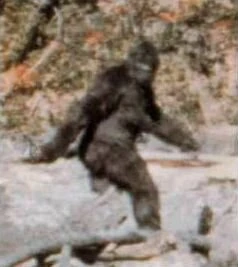
|
|
| Naming | |
| Others | Sasquatch |
| Binomen | N/A |
| Morphology | |
| Body type | Humanoid |
| Average height | ~ 2 — 2.5 meters |
| Average weight | ~ 200kg |
| Intelligence | |
| Sapience | Generally regarded as semi-sapient |
| Aggressivity | Variable |
| Ecology | |
| Place of origin | Northwestern North America |
| Habitat | Woodlands |
| Diet | Omnivorous |
| Locomotion | Bipedal |
| Lifespan | Unknown |
| Reproduction | Viviparous |
| Related species | Dustman, Grassman, Skunk Ape, Yeti, Yowie |
| Status | DD |
| Behind the Scenes | |
| Universe | Real |
Bigfoot, also known as Sasquatch, is purportedly an ape-like creature that inhabits forests, mainly in the Pacific Northwest region of North America. Bigfoot is usually described as a large, hairy, bipedal humanoid. The term «sasquatch» is an anglicized derivative of the word «Sésquac» which means «wild man» in a Salish Native American language.
A majority of scientists discount the existence of Bigfoot and consider it to be a combination of folklore, misidentification, and hoax, rather than a legitimate animal, in part because some estimate large numbers necessary to maintain a breeding population. A small minority of accredited researchers such as Jane Goodall and Jeffrey Meldrum have expressed interest and possible belief in the creature, with Meldrum expressing the opinion that evidence collected of alleged Bigfoot encounters warrants further evaluation and testing. Nevertheless, Bigfoot remains one of the more famous and controversial examples of a cryptid within cryptozoology and an enduring legend. There are several regional Bigfoots.
Description
Bigfoot is described in reports as a large hairy ape-like creature, ranging between 6–10 feet (2–3 m) tall, weighing in excess of 500 pounds (230 kg), and covered in dark brown or dark reddish hair. Alleged witnesses have described large eyes, a pronounced brow ridge, and a large, low-set forehead; the top of the head has been described as rounded and crested, similar to the sagittal crest of the male gorilla. Bigfoot is commonly reported to have a strong, unpleasant smell by those who claim to have encountered it. The enormous footprints for which it is named have been as large as 24 inches (60 cm) long and 8 inches (20 cm) wide. While most casts have five toes—like all known apes—some casts of alleged Bigfoot tracks have had numbers ranging from two to six. Some have also contained claw marks, making it likely that a portion came from known animals such as bears, which have five toes and claws. Some proponents have also claimed that Bigfoot is omnivorous and mainly nocturnal.
History
Before 1958
Wildmen stories are found among the indigenous population of the Pacific Northwest. The legends existed prior to a single name for the creature. They differed in their details both regionally and between families in the same community. Similar stories of wildmen are found on every continent except Antarctica. Ecologist Robert Michael Pyle argues that most cultures have human-like giants in their folk history: «We have this need for some larger-than-life creature.»
Members of the Lummi tell tales about Ts’emekwes, the local version of Bigfoot. The stories are similar to each other in terms of the general descriptions of Ts’emekwes, but details about the creature’s diet and activities differed between the stories of different families.
Some regional versions contained more nefarious creatures. The stiyaha or kwi-kwiyai were a nocturnal race that children were told not to say the names of lest the monsters hear and come to carry off a person—sometimes to be killed. In 1847, Paul Kane reported stories by the native people about skoocooms: a race of cannibalistic wild men living on the peak of Mount St. Helens. The skoocooms appear to have been regarded as supernatural, rather than natural.
Less menacing versions such as the one recorded by Reverend Elkanah Walker exist. In 1840, Walker, a Protestant missionary, recorded stories of giants among the Native Americans living in Spokane, Washington. The Indians claimed that these giants lived on and around the peaks of nearby mountains and stole salmon from the fishermen’s nets.
The local legends were combined together by J. W. Burns in a series of Canadian newspaper articles in the 1920s. Each language had its own name for the local version. Many names meant something along the lines of «wild man» or «hairy man» although other names described common actions it was said to perform (e.g. eating clams). Burns coined the term Sasquatch, which is from the Halkomelem sásq’ets (IPA: [ˈsæsqʼəts]), and used it in his articles to describe a hypothetical single type of creature reflected in these various stories. Burns’s articles popularized both the legend and its new name, making it well known in western Canada before it gained popularity in the United States.
After 1958
In 1951, Eric Shipton had photographed what he described as a Yeti footprint. This photograph generated considerable attention and the story of the Yeti entered into popular consciousness. The notoriety of ape-men grew over the decade, culminating in 1958 when large footprints were found in Del Norte County, California, by bulldozer operator Gerald Crew. Sets of large tracks appeared multiple times around a road-construction site in Bluff Creek. After not being taken seriously about what he was seeing, Crew brought in his friend, Bob Titmus, to cast the prints in plaster. The story was published in the Humboldt Times along with a photo of Crew holding one of the casts. Locals had been calling the unseen track-maker «Big Foot» since the late summer, which Genzoli shortened to «Bigfoot» in his article. Bigfoot gained international attention when the story was picked up by the Associated Press. Following the death of Ray Wallace – a local logger – his family attributed the creation of the footprints to him. The wife of Scoop Beal, the editor of the Humboldt Standard, which later combined with the Humboldt Times, in which Genzoli’s story had appeared, has stated that her husband was in on the hoax with Wallace.
1958 was a watershed year for not just the Bigfoot story itself but also the culture that surrounds it. The first Bigfoot hunters began following the discovery of footprints at Bluff Creek. Within a year, Tom Slick, who had funded searches for Yeti in the Himalayas earlier in the decade, organized searches for Bigfoot in the area around Bluff Creek.
As Bigfoot has become better known and a phenomenon in popular culture, sightings have spread throughout North America. In addition to the Pacific Northwest, the Great Lakes region and the Southeastern United States have had many reports of Bigfoot sightings.
Prominent reported sightings
Distribution of reported Bigfoot sightings in Anglo-America.
About a third of all Bigfoot sightings are concentrated in the Pacific Northwest, with most of the remaining sightings spread throughout the rest of North America. Some Bigfoot advocates, such as cryptozoologist John Willison Green, have postulated that Bigfoot is a worldwide phenomenon. The most notable sightings include:
- 1924: Fred Beck claimed that he and four other miners were attacked one night in July 1924, by several «apemen» throwing rocks at their cabin in an area later called Ape Canyon, Washington. Beck claimed the miners shot and possibly killed at least one of the creatures, precipitating an attack on their cabin, during which the creatures bombarded the cabin with rocks and tried to break-in. The incident was widely reported at the time. Beck wrote a book about the event in 1967, in which he argued that the alleged creatures were mystical beings from another dimension, claiming that he had experienced psychic premonitions and visions his entire life of which the apemen were only one component. Speleologist William Halliday argued in 1983 that the story arose from an incident in which hikers from a nearby camp had thrown rocks into the canyon. There are also local rumors that pranksters harassed the men and planted faked footprints.
- 1941: Jeannie Chapman and her children claimed to have escaped their home when a large Sasquatch, allegedly 7.5 feet (2.3 m) tall, approached their residence in Ruby Creek, British Columbia.
- 1958: Bulldozer operator Jerry Crew took to a newspaper office a cast of one of the enormous footprints he and other workers had been seeing at an isolated work site at Bluff Creek, California. The crew was overseen by Wilbur L. Wallace, brother of Raymond L. Wallace. After Ray Wallace’s death, his children came forward with a pair of 16-inch (41 cm) wooden feet, which they claimed their father had used to fake the Bigfoot tracks in 1958. Wallace is poorly regarded by many Bigfoot proponents. John Napier wrote, «I do not feel impressed with Mr. Wallace’s story» regarding having over 15,000 feet (4,600 m) of film showing Bigfoot.
- 1967: Roger Patterson and Robert Gimlin reported that on October 20 they had captured a purported Sasquatch on film at Bluff Creek, California. This came to be known as the Patterson-Gimlin film, which is purported to be the best evidence of Bigfoot by many advocates. Many years later, Bob Heironimus, an acquaintance of Patterson’s, claimed that he had worn an ape costume for the making of the film.
- 2007: On September 16, 2007, hunter Rick Jacobs captured an image of a possible sasquatch using an automatically triggered camera attached to a tree, prompting a spokesperson for the Pennsylvania Game Commission to say that it was likely an image of «a bear with a severe case of mange.» Australian scientist and journalist Vanessa Woods wrote in «Scientriffic», a bimonthly magazine for ages 7+, that her Duke University colleague’s informal measurements showed that the proportions of the creature were not similar to a bear’s, although they could not discount the possibility that it was a hoax. The sighting happened near the town of Ridgway, Pennsylvania, in the Allegheny National Forest.
Appearances in Popular Media
Depictions of Bigfoot in popular media have been extremely varied, as it has been featured in comedy, fantasy and horror, and may be portrayed as anything, from savage near-human to supernatural beast; from man-sized to almost daikaiju-sized; from murderous brute to gentle giant. It is also relatively common for it to be mistakenly referred to as «Abominable Snowman» or even «Yeti» — names that should be reserved for the unrelated creature from the Himalayas.
In a particularly interesting occurrence, in the sci-fi series The Invisible Man (2000 – 2002) the chemical substance which grants the main character the ability to become invisible is produced by a gland taken from a sasquatch corpse, explaining that the creature has invisibility as a natural skill, which accounts for how it has managed to evade scientific detection for so long.
In Brett Davis’ fantasy novel The Faery Convention, Bigfoots and Sasquatches appear among the several sapient races of «supernaturals» which have been living in the woodlands, hiding themselves from humanity. The terms «Bigfoot» and «Sasquatch» are not synonymous in this case, as the two are noted as being related but not quite the same.
In the animated series The Real Ghostbusters, Bigfoot is a being native to another dimension which escaped to our own world by entering a time warp.
Other works featuring Sasquatches or creatures closely similar, and/or identified as such, include:
- Abominable (2006)
- Back at the Barnyard, episodes «Otis Vs. Bigfoot» (2008) and «Mission: Save Bigfoot» (2010)
- Bigfoot (1970)
- Bigfoot (1987)
- Bigfoot (2006)
- Bigfoot (2009)
- Bigfoot (2012)
- Sasquatch, the Legend of Bigfoot (1976)
- The Capture of Bigfoot (1979)
- Revenge of Bigfoot (1979)
- Clawed: The Legend of Sasquatch (2005), a.k.a. The Unknown
- The Sasquatch Gang (2006), a.k.a. The Sasquatch Dumpling Gang
- Devil on the Mountain (2006), a.k.a. Sasquatch Mountain
- Donald Duck Adventures, comic «The Search for Bigfoot» (2002)
- DuckTales, episode «Ducky Horror Picture Show» (1987) (Mentioned only)
- Goof Troop, episode «Winter Blunderland» (1992)
- Dexter’s Laboratory, episode «Sassy Come Home» (1997)
- Courage the Cowardly Dog, episode «Courage Meets Bigfoot» (1999)
- Tom and Jerry Tales, episode «Sasquashed» (2007)
- SheZow, episode «SheSquatch» (2013)
- A Goofy Movie (1995)
- Curse of Bigfoot (1975)
- Little Bigfoot (1997)
- Harry and the Hendersons (1987)
- The Cabin in the Woods (2012)
- Hotel Transylvania (2012), cameo
- The Legend of Sasquatch (2006)
- Bedtime Stories (2008), cameo
- Letters from the Big Man (2011)
- Monsters, Inc. (2001) (Mentioned only)
- Night of the Demon (1980)
- Sanctuary (2008 – 2011)
- Sasquatch (2002), a.k.a. The Untold
- Sasquatch Hunters (2005)
- Snowbeast (1977)
- Snowbeast (2011)
- Missing Link (2019)
- Valley of the Sasquatch (2015)
- The Son of Bigfoot (2017)
- WarioWare Gold (2018)
- Tomb Raider II: Golden Mask (1999)
- Tony Hawk’s Underground 2 (2004)
- Grand Theft Auto V (2013)
- They Call him Sasquatch (2003)
- The Sims 2 (2004)
- The Thing, episode «Bigfoot Meets The Thing» (1979)
- Teenage Mutant Ninja Turtles, episode «A Foot Too Big» (2014)
- Timon & Pumbaa, episode «Bigfoot, Littlebrain» (1999)
- The Powerpuff Girls, episode «Say Uncle» (2004)
- DuckTales reboot, episodes «The Other Bin of Scrooge McDuck!» (2018) and «The Richest Duck in the World!» (2019)
- Vampirina, episode «Uncle Bigfoot» (2018)
- We Bare Bears Charlie.
- Red Dead Redemption (2010)
Gallery
Bigfoot (1970)
Bigfoot and Wildboy (1977)
The Thing, episode «Bigfoot Meets The Thing» (1979)
The Richie Rich/Scooby-Doo Show (1981)
The Scooby & Scrappy Doo/Puppy Hour (1982)
Bigfoot (1987)
The Real Ghostbusters (1987)
A Pup Named Scooby-Doo (1989)
Goof Troop (1992)
Dexter’s Laboratory (1997)
Timon and Pumbaa (1999)
Tomb Raider II: Golden Mask (1999)
Family Guy (1999)
Courage the Cowardly Dog (1999)
The Search for Bigfoot (2002)
Futurama (2003)
31 Minutos (2005)
The Legend of Sasquatch (2006)
Sheldon from Tom and Jerry Tales (2007)
Back at the Barnyard (2008)
Sanctuary (2008)
Bigfoot (2009)
Red Dead Redemption (2010)
Letters from the Big Man (2011)
Snow Beast (2011)
Bigfoot (2012)
Gravity Falls (2012)
SheZow (2013)
Mr. Pickles (2014)
American Dad (2014)
Teenage Mutant Ninja Turtles (2014)
The Venture Bros.
The Son of Bigfoot (2017)
Welcome to Duckburg (2017)
Vampirina (2018)
DuckTales (2018)
WarioWare Gold (2018)
Missing Link (2019)
Brewster Rockit: Space Guy! (2021)
Weird n’ Wild Creatures
Mr. Peabody & Sherman Show



